Vernier Software and Technology LQ2-LE LabQuest2 User Manual
Vernier Software & Technology LabQuest2
User manual
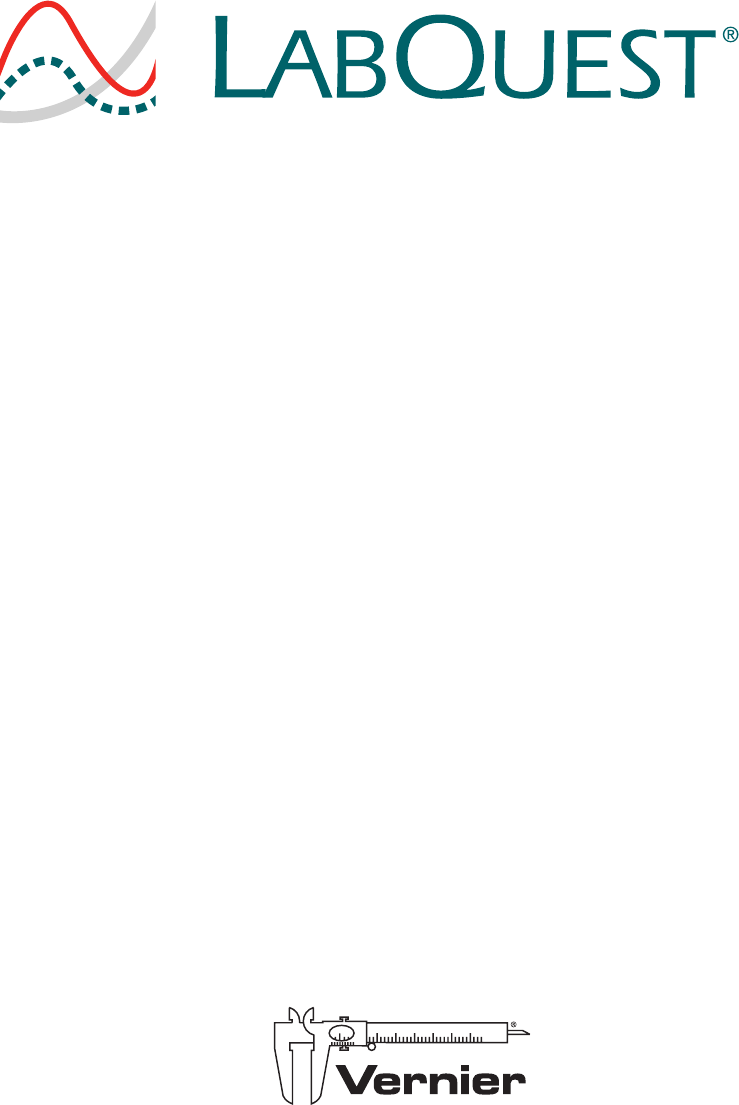
2
Reference Guide
v1.01
©Vernier Software & Technology

LabQuest 2 Reference Guide
i
SAFETY INFORMATION
Federal Communication Commission Interference Statement
This equipment has been tested and found to comply with the limits for a Class B digital device,
pursuant to Part 15 of the FCC rules. These limits are designed to provide reasonable protection
against harmful interference in a residential installation. This equipment generates, uses and can
radiate radio frequency energy and, if not installed and used in accordance with the instructions,
may cause harmful interference to radio communications. However, there is no guarantee that
interference will not occur in a particular installation. If this equipment does cause harmful
interference to radio or television reception, which can be determined by turning the equipment
off and on, the user is encouraged to try to correct the interference by one or more of the
following measures:
Reorient or relocate the receiving antenna.
Increase the separation between the equipment and receiver.
Connect the equipment into an outlet on a circuit different from that to which the receiver
is connected.
Consult the dealer or an experienced radio/TV technician for help.
FCC Caution
This device complies with Part 15 of the FCC Rules. Operation is subject to the following two
conditions:
(1) this device may not cause harmful interference and
(2) this device must accept any interference received, including interference that may cause
undesired operation
RF Exposure Warning
The equipment complies with RF exposure limits set forth for an uncontrolled environment. The
antenna(s) used for this transmitter must not be co-located or operating in conjunction with any
other antenna or transmitter.
You are cautioned that changes or modifications not expressly approved by the party responsible
for compliance could void your authority to operate the equipment.
IC Statement
This device complies with Industry Canada license-exempt RSS standard(s). Operation is subject
to the following two conditions: (1) this device may not cause interference, and (2) this device
must accept any interference, including interference that may cause undesired operation of the
device.
Industry Canada - Class B This digital apparatus does not exceed the Class B limits for radio
noise emissions from digital apparatus as set out in the interference-causing equipment standard
entitled “Digital Apparatus,” ICES-003 of Industry Canada. Operation is subject to the following
two conditions: (1) this device may not cause interference, and (2) this device must accept any
interference, including interference that may cause undesired operation of the device. To reduce
potential radio interference to other users, the antenna type and its gain should be so chosen that
the equivalent isotropically radiated power (e.i.r.p.) is not more than that permitted for successful
communication.

LabQuest 2 Reference Guide
ii
RF exposure warning: The equipment complies with RF exposure limits set forth for an
uncontrolled environment. The antenna(s) used for this transmitter must not be co-located or
operating in conjunction with any other antenna or transmitter.
Le présent appareil est conforme aux CNR d’Industrie Canada applicables aux appareils radio
exempts de licence. L’exploitation est autorisée aux deux conditions suivantes : (1) l’appareil ne
doit pas produire de brouillage, et (2) l’appareil doit accepter tout interférence radioélectrique,
même si cela résulte à un brouillage susceptible d’en compromettre le fonctionnement.
Cet appareil numérique respecte les limites de bruits radioélectriques applicables aux appareils
numériques de Classe B prescrites dans la norme sur le matériel interférant-brouilleur:
“Appareils Numériques,” NMB-003 édictée par industrie Canada. L’utilisation est soumise aux
deux conditions suivantes: (1) cet appareil ne peut causer d’interférences, et (2) cet appareil doit
accepter toutes interférences, y comprises celles susceptibles de provoquer un disfonctionnement
du dispositif. Afin de réduire les interférences radio potentielles pour les autres utilisateurs, le
type d’antenne et son gain doivent être choisie de telle façon que l’équivalent de puissance
isotrope émis (e.i.r.p) n’est pas plus grand que celui permis pour une communication établie.
Avertissement d’exposition RF: L’équipement est conforme aux limites d’exposition aux RF
établies pour un environnement non supervisé. L’antenne (s) utilisée pour ce transmetteur ne
doit pas être jumelés ou fonctionner en conjonction avec toute autre antenne ou transmetteur.
ABOUT THIS GUIDE
LabQuest 2, released in March 2012, ships with a Quick-Start Guide intended to get you up
and running with basic data collection and analysis. The LabQuest 2 Reference Guide is an
extended guide designed as a comprehensive resource detailing the features, hardware, and
software of LabQuest 2.

LabQuest 2 Reference Guide
iii
CONTENTS
I. GETTING STARTED WITH LABQUEST 2 ......................................................................................... 1
What’s Included .................................................................................................................1
Using LabQuest 2 for the First Time ..................................................................................1
Quick Start to Data Collection ...........................................................................................2
II. LABQUEST HARDWARE .................................................................................................................... 4
Power Button ......................................................................................................................4
Touch Screen ......................................................................................................................5
Hardware Keys ...................................................................................................................5
Sensor Ports ........................................................................................................................5
Internal Sensors ..................................................................................................................6
III. LABQUEST APP .................................................................................................................................. 7
Navigating LabQuest App ..................................................................................................8
File Menu ...........................................................................................................................9
Data Collection .................................................................................................................11
Data Analysis ...................................................................................................................18
Viewing Vernier Lab Instructions ....................................................................................24
Adding Notes to Your Experiment ...................................................................................25
Storing LabQuest App Files .............................................................................................25
Exporting LabQuest App files ..........................................................................................26
Printing from LabQuest App ............................................................................................26
IV. USING LABQUEST 2 WITH A MOBILE DEVICE ............................................................................. 28
V. USING LABQUEST WITH A COMPUTER ........................................................................................ 31
Collecting Data with Logger Lite or Logger Pro .............................................................31
Transferring Data from LabQuest to a Computer ............................................................31
VI. EMAILING FROM LABQUEST .......................................................................................................... 33
VII. WIRELESSLY PRINTING FROM LABQUEST .................................................................................. 34
VIII. PROJECTING AND MONITORING STUDENTS’ LABQUEST DEVICES ........................................ 35
IX. ADDITIONAL APPS ON LABQUEST ................................................................................................ 36
Audio Function Generator ................................................................................................36
Periodic Table ...................................................................................................................36
Power Amplifier ...............................................................................................................37
Calculator .........................................................................................................................37
Sound Recorder ................................................................................................................37
Stopwatch .........................................................................................................................37
APPENDIX A. LABQUEST 2 TECHNICAL SPECIFICATIONS
APPENDIX B. LABQUEST MAINTENANCE
APPENDIX C. LICENSE INFORMATION
APPENDIX D. WARRANTY
APPENDIX E. ACCESSORIES, REPLACEMENT PARTS, AND RELATED PRODUCTS
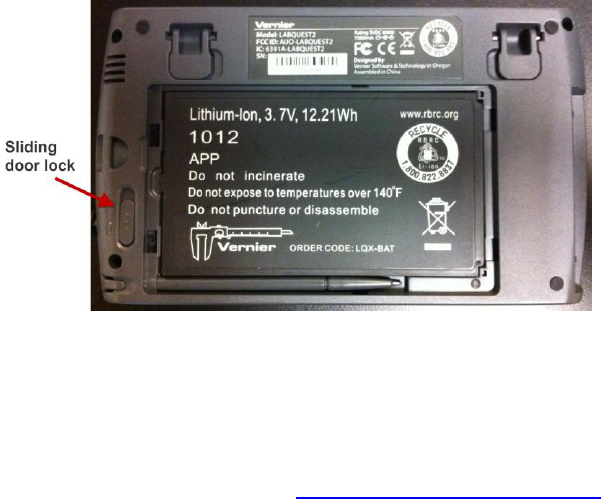
I. GETTING STARTED WITH LABQUEST 2
What’s Included
LabQuest 2 interface
Rechargeable battery
Power adapter
USB cable
Quick-Start Guide
Stylus (in unit)
Stylus tether
Logger Lite CD
Using LabQuest 2 for the First Time
Install the Battery
LabQuest 2 ships without the battery installed. To install the battery, follow these simple
instructions.
Turn LabQuest over and open the battery door by sliding the door lock and lifting the
battery cover.
Remove the small protective sticker covering the battery contacts.
Install the battery with the label side up, ensuring the battery contacts align with the
contacts on LabQuest.
Replace the battery door and make sure the door lock clicks closed.
LabQuest with battery door removed
Charge for 8 Hours
We recommend charging the battery for eight hours prior to using LabQuest for the first time on
battery power. To do this, connect the included power adapter to LabQuest and an AC power
source. You can also charge LabQuest using the LabQuest 2 Charging Station (order code
LQ2-CRG, sold separately).
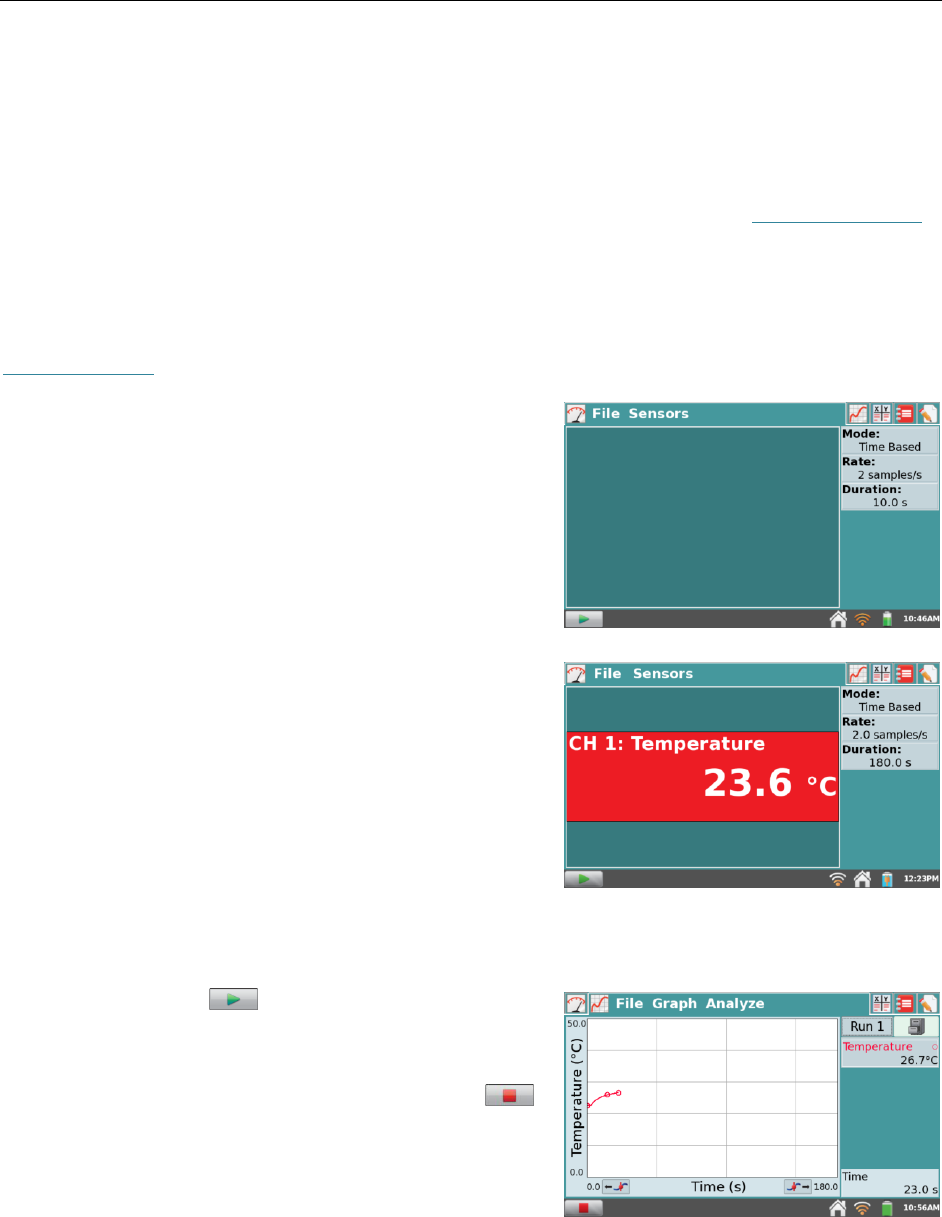
Getting Started with LabQuest 2
2
LabQuest uses a high-quality lithium-ion battery. This is the same chemistry used in premium
laptop and cell phone batteries, and you can expect similar performance. There is never a need to
condition the battery by regular full discharge/charge cycles.
It is safe to leave the battery charging indefinitely, and there is no need to fully discharge the
battery before charging. Battery life will depend on the sensors used, but in most cases you can
obtain six or more hours of use before recharging. We recommend charging LabQuest overnight
to start the next day with a full charge. For more details about the battery, see LabQuest Battery.
Quick Start to Data Collection
Follow these steps to get up and running quickly with basic data collection. For more details, see
Data Collection.
1. Turn on LabQuest by pressing and releasing the
power button located on the top edge of LabQuest.
The LabQuest App will launch automatically.
2. Connect an analog sensor to the CH 1 port on
LabQuest (or connect a digital sensor to the DIG 1
port). LabQuest App will auto-ID the connected
sensor and automatically set up the default
collection rate for the sensor.
Note: If your sensor is an older-style (DIN) sensor
requiring an adapter, the sensor will not auto-ID.
Instead, you will need to set up the sensor manually.
To do this, tap the Sensors menu and choose Sensor
Setup. Next, tap the field labeled “No Sensor” adjacent to the appropriate port to view a list
of sensors. Tap to select the sensor.
3. Next, tap Collect . Data collection will begin
and LabQuest will graph the data collection in real
time.
You can stop collection early by tapping Stop .
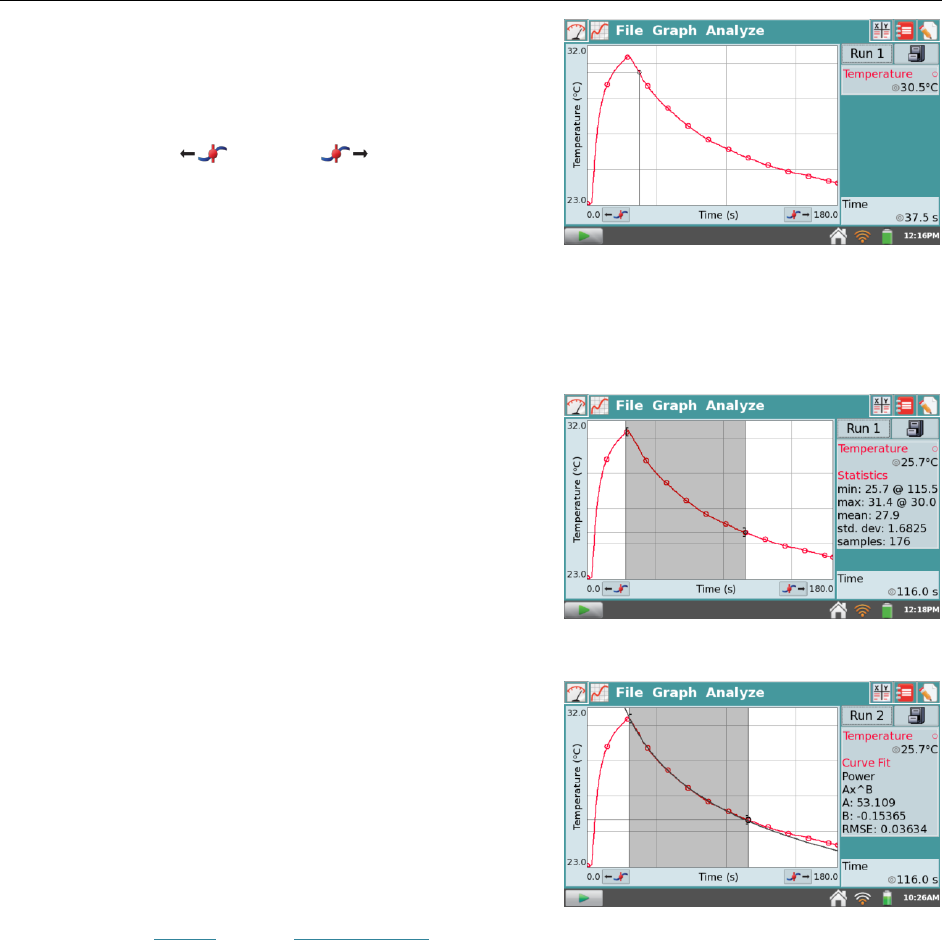
Getting Started with LabQuest 2
3
4. Once data collection is complete, the graph
autoscales to the data. Tap the graph to examine a
point of interest. The coordinates of the point are
shown in the pane to the right of the graph. Tap
another point or tap the Examine buttons to move
the cursor left and right .
5. To select a region of data for analysis, tap-and-drag
across the graph to highlight the desired region.
Note: To analyze all of the data, you do not need to select a region.
Statistics
To view statistics for the selected data, tap Analyze
on the Graph screen, then choose Statistics. Tap the
checkbox to select a data set. The statistics
information is then displayed in the panel to the
right of the graph.
To remove the displayed statistics, tap Analyze on
the Graph screen, choose Statistics, then tap the
checkbox to unselect the data set.
Curve Fit
To fit a curve to the selected data, tap Analyze on
the Graph screen, then choose Curve Fit. Tap the
checkbox to select a data set. On the Curve Fit
screen, tap Choose Fit, then choose the type of
equation you would like to fit to the data.
LabQuest App will automatically determine the fit
coefficients. A preview of the fit applied to the data
Note: The Curve Fit coefficients cannot be manually
adjusted. To enter your own parameters, see the
sub-section Model within Data Analysis.
On the Curve Fit screen, tap OK to apply the fit and return to the Graph screen.
To remove the fit, tap Analyze on the Graph screen, choose Curve Fit, then tap the checkbox
to unselect the data set.
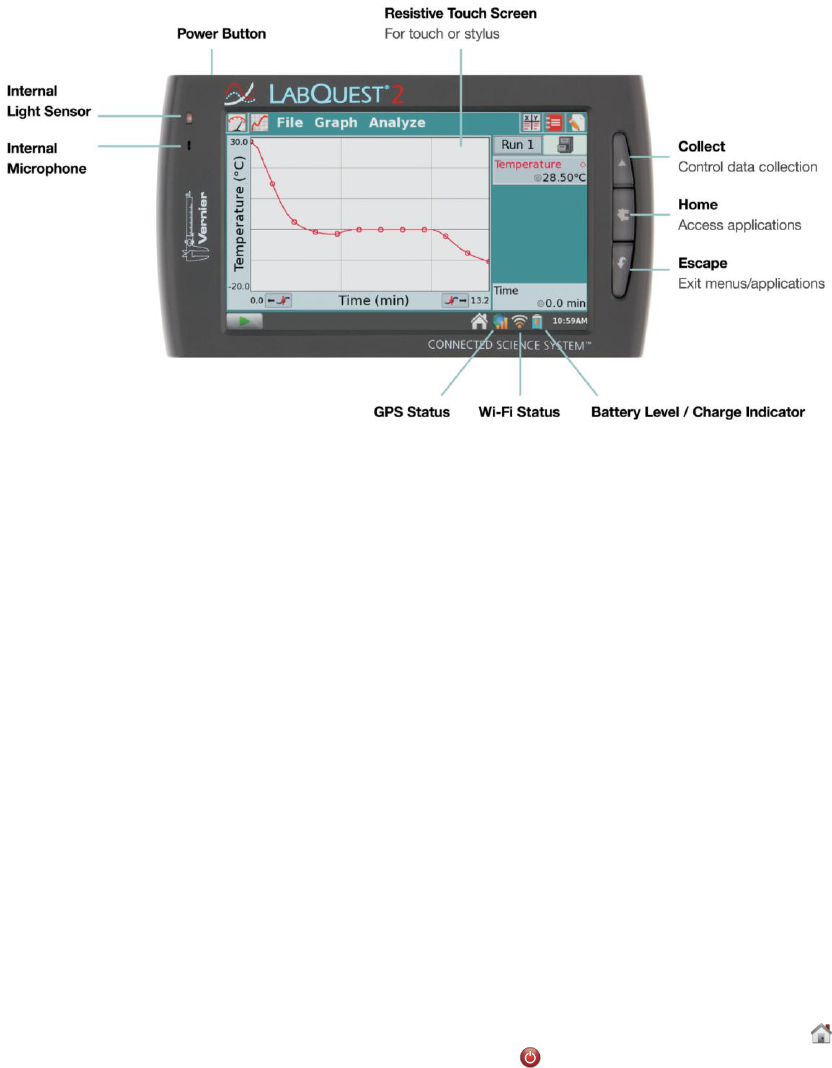
II. LABQUEST HARDWARE
Once LabQuest 2 is connected to AC power or the battery has been charged, press the power
button located on the top of the unit, near the left edge. LabQuest will complete its booting
procedure and then launch the LabQuest App by default, as shown above. If the screen does not
light after a moment, connect the power adapter to LabQuest and to an AC power source and try
the button again.
Power Button
Power on – If the screen is off for any reason (LabQuest is off, asleep, or the screen has
turned off to conserve battery power) pressing and releasing the power button once will
turn LabQuest back on. If LabQuest was off, LabQuest will also complete its booting
procedure which takes about a minute and then display LabQuest App.
Sleep/wake – When LabQuest is on, pressing and releasing the power button once will
put LabQuest into a sleep mode. Note that the sleep mode does not start until you release
the power button. In this mode, LabQuest uses less power but the battery can still drain.
This mode is useful if you are going to return to data collection again soon, in which case
waking LabQuest from sleep is quicker than a cold boot. To wake LabQuest from sleep,
simply press and release the power button.
Shut down – To shut down LabQuest, hold the power button down for about five
seconds. You will then see a message indicating that LabQuest is shutting down. Release
the power button, and allow LabQuest to shutdown. To cancel the shutdown procedure at
this point, simply tap Cancel. You can also shutdown LabQuest by tapping Home ,
tapping the System folder, then tapping Shut Down .
Emergency Shutdown – If you hold the power button down for about eight seconds, the
unit will power off uncleanly. This is the same as pulling the battery out of the unit while
it is running. This is not recommended unless LabQuest is frozen, as you may lose your
data and potentially cause file system corruption.
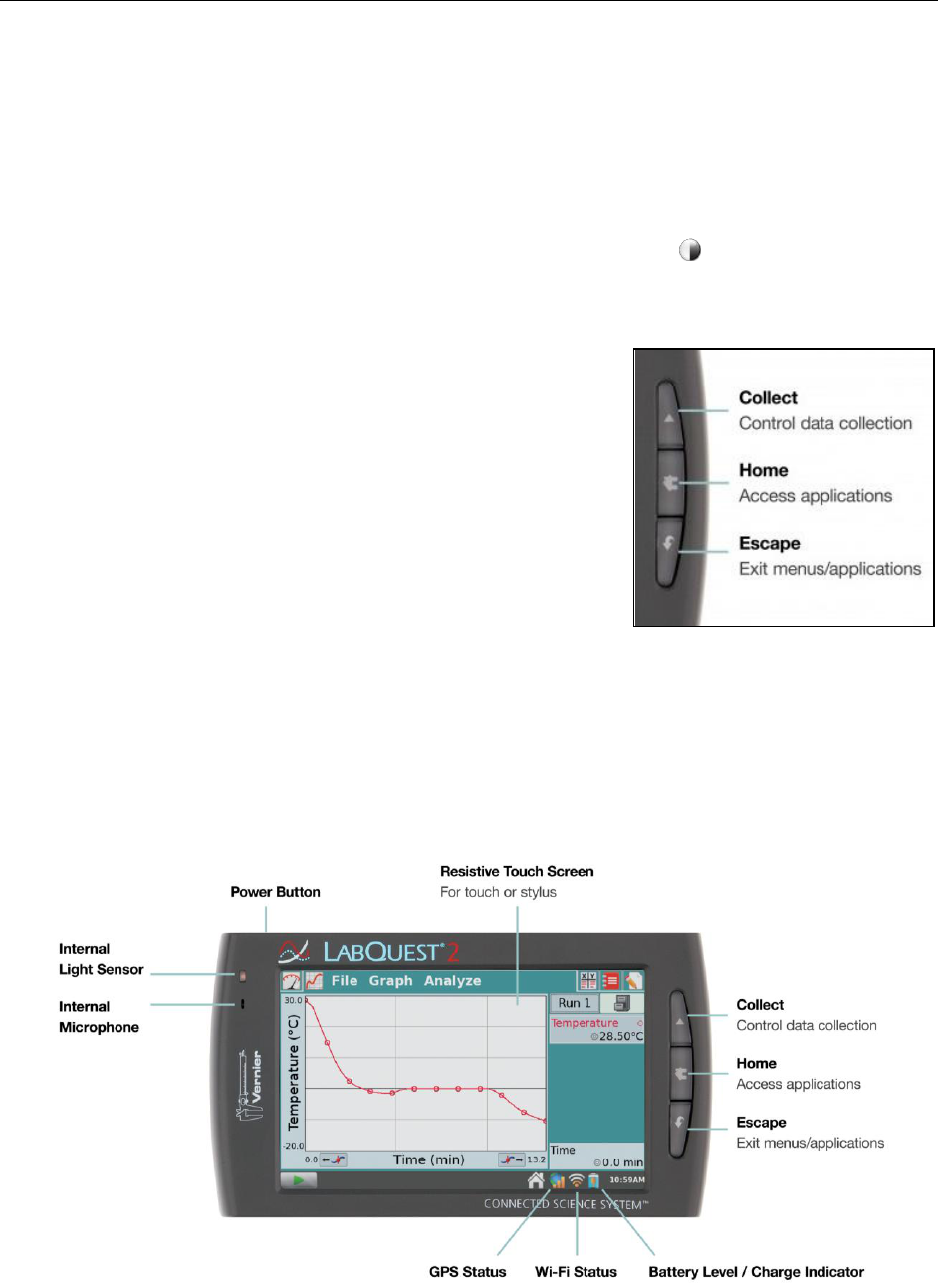
LabQuest Hardware
5
Touch Screen
LabQuest has an LED backlit resistive touch screen that quickly responds to pressure exerted on
the screen. LabQuest is controlled primarily by touching the screen. The software is designed to
be finger-friendly. In some situations, you may desire having more control for precise
navigation. In such cases, we recommend using the included stylus.
If you are having trouble viewing the color screen or are using LabQuest outside in bright
sunlight, we recommend changing to the High Contrast mode. From the Home menu, tap
Preferences, then Light & Power. Tap the checkbox for High Contrast to enable this mode.
Hardware Keys
In addition to using the touch screen, the three hardware keys
can also be used to control your LabQuest.
Collect – This key starts and stops data collection within
LabQuest App
Home – This key launches the Home screen
Escape – This key closes most applications, menus, and
exits dialog boxes without taking action (i.e., cancels
dialog boxes)
Sensor Ports
LabQuest has three analog sensor ports (CH 1, CH 2, and CH 3) for analog sensors such as our
pH Sensor, Temperature Sensor, and Force Sensor. Also included is a full-size USB port for
USB sensors, USB thumb drives, and USB printers. In addition to the power button, the top edge
of LabQuest has two digital sensor ports (DIG 1 and DIG 2) for Motion Detectors, Drop
Counters, and other digital sensors.
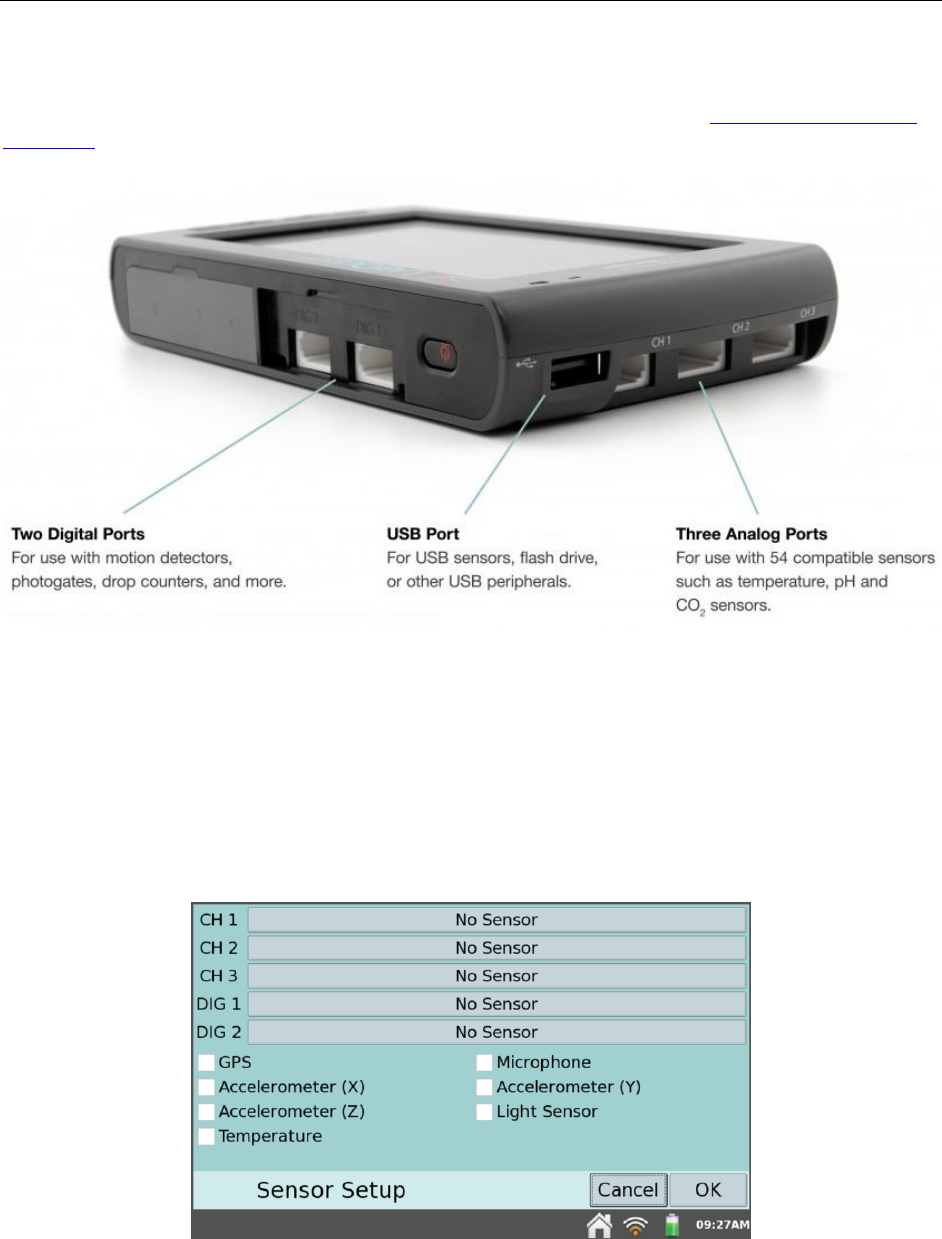
LabQuest Hardware
6
Also located on the top edge are the audio ports and a micro SD card slot for expanding disk
storage. On the side opposite of the analog ports, there is a stylus storage slot, an AC power port
for recharging the battery, and a mini USB port for connecting LabQuest to a computer. In
between these ports, there is a serial connection for charging the unit in a LabQuest 2 Charging
Station (order code LQ2-CRG, sold separately), and a stylus tether attachment point.
Internal Sensors
LabQuest also has several built-in sensors, including a GPS, microphone, accelerometers,
temperature sensor, and relative light sensor.
To enable internal sensors within LabQuest App, tap Sensors, and choose Sensor Setup. Within
the Sensor Setup dialog box, tap a checkbox to enable the associated sensor. Then tap OK to
return to the LabQuest App Meter screen.
Sensor Setup dialog box

LabQuest Hardware
7
To enable internal sensors within LabQuest App, tap Sensors, and choose Sensor Setup. Within
the Sensor Setup dialog box, tap a checkbox to enable the associated sensor. Then tap OK to
return to the LabQuest App Meter screen.
GPS – The internal GPS collects latitude, longitude, and altitude readings, and may be
used with other sensors. You can choose units of decimal degrees, degree minutes, or
UTM. Note: It may take up to 15 minutes to acquire an initial signal outdoors. We do not
recommend using the GPS indoors.
Microphone – The internal Microphone is located on the top surface of LabQuest and
measures waveforms. Note: This sensor cannot be used with external sensors.
Accelerometers – The Accelerometers measure accelerations up to 2 g in the x-, y- and
z-axis directions.
Light Sensor – The internal Light Sensor is located on the top surface of LabQuest. This
is an uncalibrated sensor which measures visible light intensity.
Temperature – The internal Temperature Sensor monitors ambient temperature.
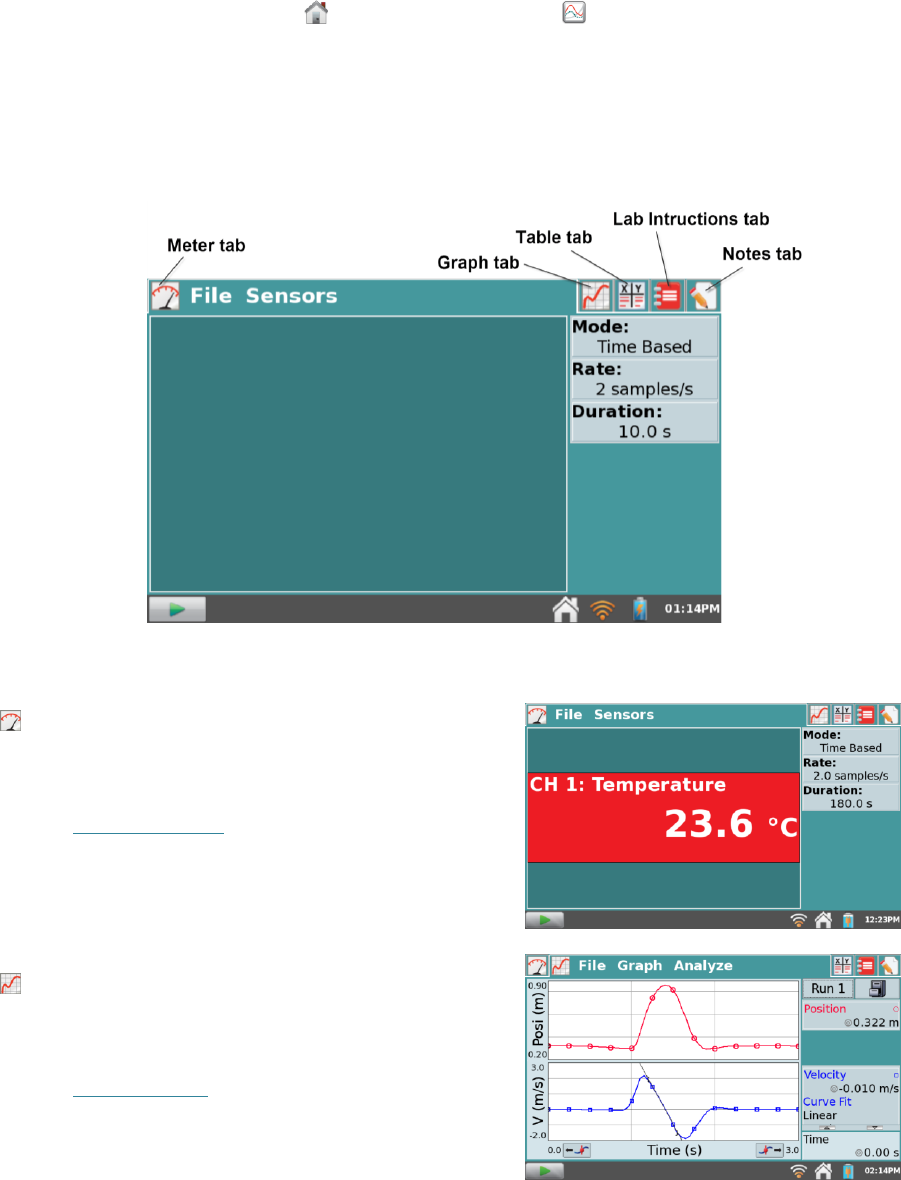
III. LABQUEST APP
The data-collection and analysis software, LabQuest App, is the heart of your LabQuest. When
you turn on LabQuest, the LabQuest App starts automatically. If the LabQuest App is not
showing on your screen, tap Home , and tap LabQuest App .
Navigating LabQuest App
The LabQuest App has five different screens. Tap on the desired tab to display the associated
screen.
LabQuest App
Meter screen – Set up sensors, data-collection
parameters, and see a digital meter for your
connected sensors. For a detailed description of
how the Meter screen is used for data collection,
see Data Collection.
Graph screen – See a graph of your data and
perform statistical analysis of your data,
including curve fits. For a detailed description of
how the Graph screen is used for data analysis,
see Data Analysis.
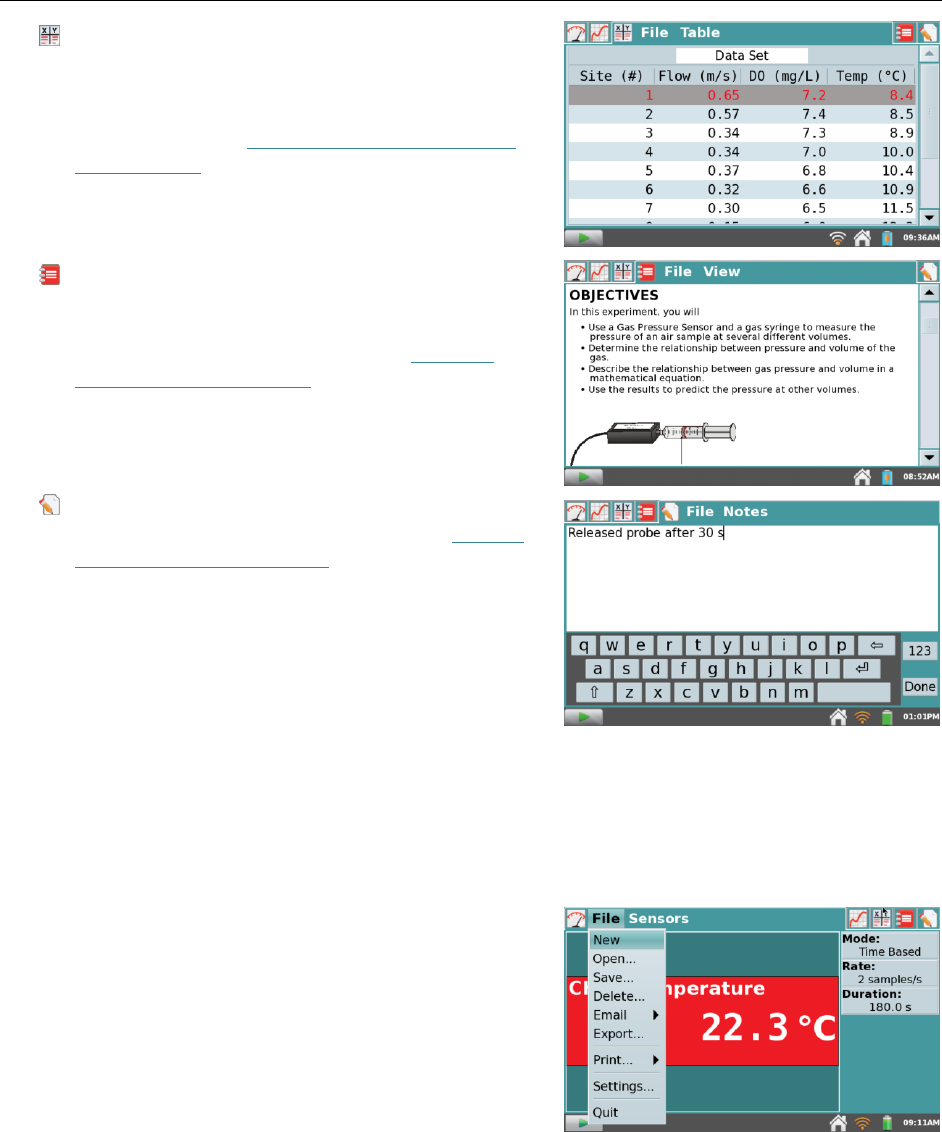
LabQuest App
9
Table screen – See a tabular representation of
your data, create manual and calculated
columns, and manually enter data. For a detailed
description of how the Table screen is used for
data analysis, see Manipulating Data from the
Table Screen.
Lab Instructions screen – Access one of over
100 preloaded labs for paperless labs (more labs
are available online). For detailed instructions
for how to add additional labs, see Viewing
Vernier Lab Instructions.
Notes screen – Record observations about your
experiment. For more information, see Adding
Notes to Your Experiment.
File Menu
A LabQuest App file can contain data collection settings, graphs, data tables, analyses, and even
notes. These files have a .qmbl extension and can be saved to the internal storage space on
LabQuest or to an external storage space such as a USB thumb drive or micro SD card.
LabQuest App files can also be opened and manipulated on a computer with our Logger Pro
software.
All five tabs within LabQuest App share the same File
menu which is similar to the File menu on a computer.
From the File menu, you can perform a number of tasks
related to LabQuest App files, such as opening, saving,
and closing files, adjusting file settings, printing, and
more. These are described in more detail as follows.
New – Choosing New from the File menu will
close the existing file and open a new file. If you
have unsaved data, you will be prompted to
either save or discard the data before continuing. This is an easy way to reset the data
collection mode and calibrations back to default values.
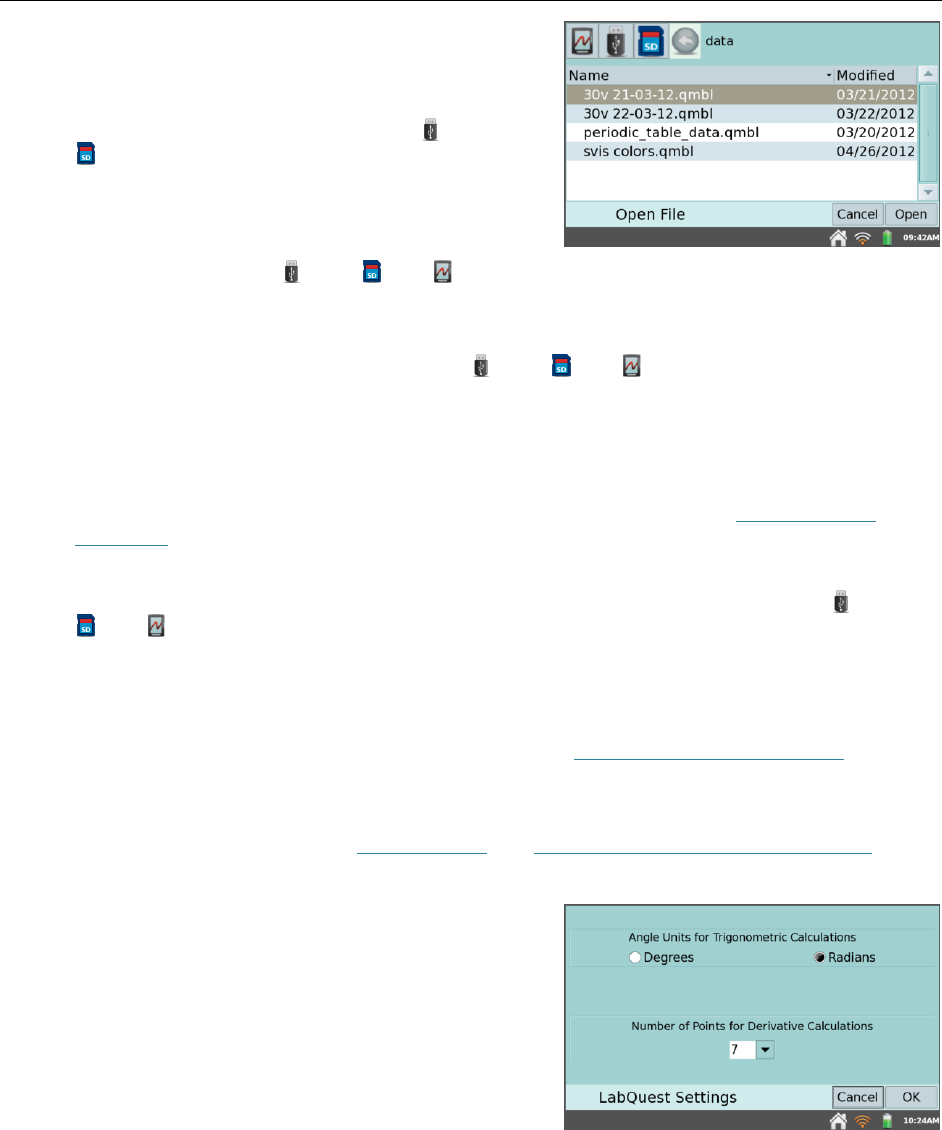
LabQuest App
10
Open – Choosing Open from the File menu
displays a list of files that you have saved on
LabQuest. To open a file, tap on the file name,
then tap Open. To open a file from an external
storage source, tap the source icon ( USB,
SD) to display the files available on that
source, then tap on the file name, and tap Open.
Save – Choosing Save from the File menu
displays the Save As dialog box where you can
tap on a source icon ( USB, SD, LabQuest) to select a destination, then tap in the
File name field to assign a name to the file.
Delete – Choosing Delete from the File menu displays a file list similar to that accessible
by choosing open. Tap on a source icon ( USB, SD, LabQuest) to select the source
of the file to be deleted, then tap the file name to be deleted, then tap Delete. You can
delete only one file at a time.
Email – Choosing Email from the File menu allows you to email the Data File, Graph,
Text File, or Screen Shot from the current file, if you are connected to a wireless network
with Internet. For detailed instructions on setting up this feature, see Emailing from
LabQuest.
Export– Choosing Export from the File menu allows you to export the currently opened
data file in a text format for use with other applications. Tap on a source icon ( USB,
SD, LabQuest) to select a destination, then tap OK to complete the export.
A typical use of this feature is to export a text file to an SD card or a USB flash drive for
further data manipulation on a computer with a spreadsheet program. The exported file
contains all column values from all runs in the current session, delimited by tabs. For
more detailed instructions on using this feature, see Storing LabQuest App Files.
Print – Choosing Print from the File menu allows you to print the Graph, Table, Lab
Instructions, Notes, or Screen from the current file to a USB or Wi-Fi-enabled printer.
For detailed instructions, see USB Printing and Wirelessly Printing from LabQuest,
respectively.
Settings – Choosing Settings from the File menu
allows you to adjust file settings for the current
session. These settings are not global; rather,
they are specific to and saved within the
LabQuest file. These settings return to the
default upon choosing New from the File menu.
o Angle Units for Trigonometric Calculcations -
Calculated columns, curve fits, and modeled
functions may use trigonometric
calculations; choose Degrees or Radians
here. The default is set to radians.
o Number of Points for Derivative Calculations – Calculated columns, curve fits,
modeled functions, and even the automatic setup for sensors (e.g., Motion Detectors)
may use numerical derivatives. The algorithm for such derivatives utilizes a user-
defined number of points. The default value of seven points is good for many
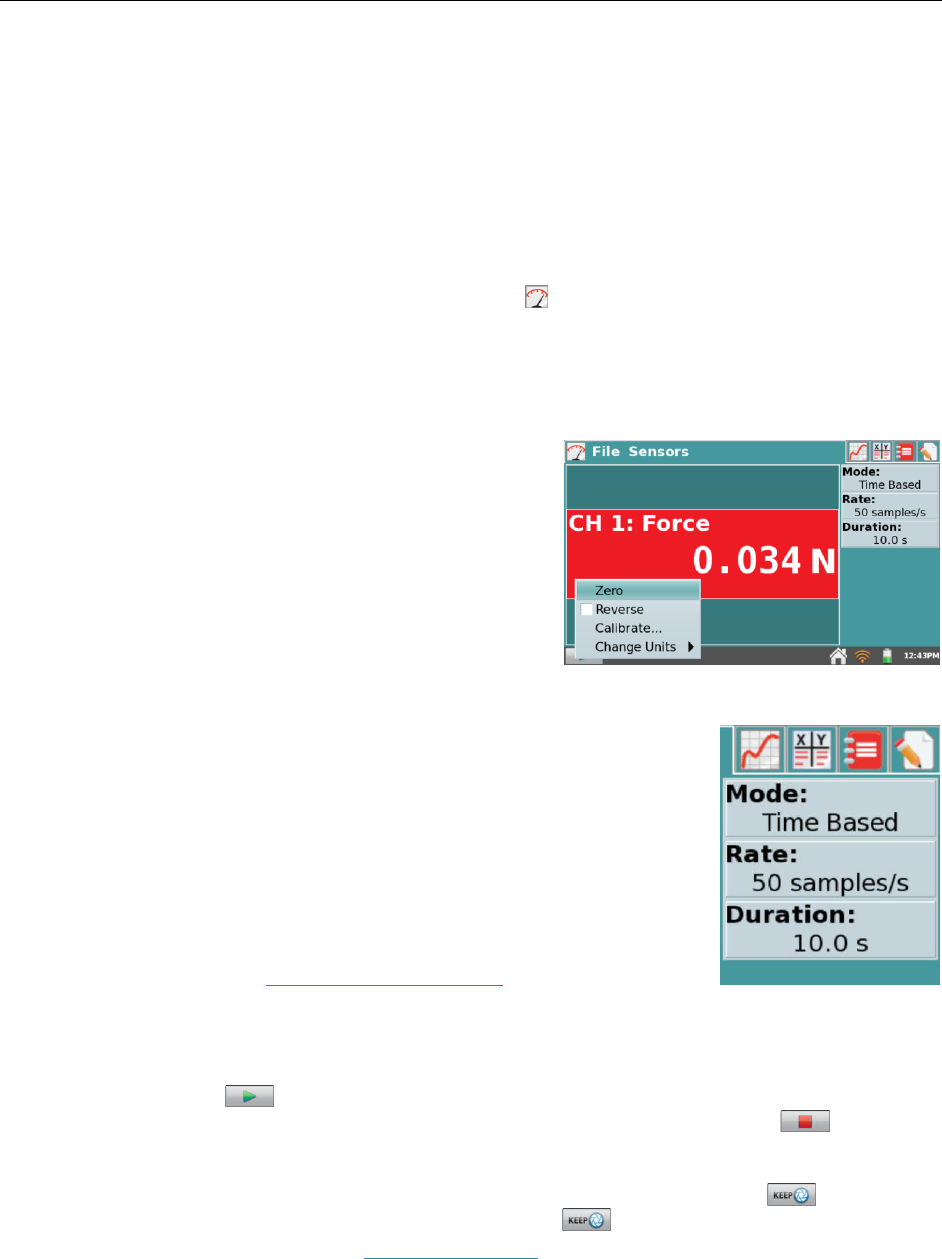
LabQuest App
11
experiments but you may want to choose a larger number for human-scale Motion
Detector experiments (e.g., our Motion Match lab), or a smaller number for cart-
based Motion Detector experiments (e.g., our Impulse and Momentum lab).
Quit – Choosing Quit from the File menu exits the LabQuest App. Since other
applications can be run simultaneously with LabQuest App, there is typically no need to
quit the LabQuest App during standard use.
Data Collection
The Meter screen, selectable by tapping the Meter tab , is the default view for the
LabQuest App. Use the Meter screen to set up your sensors and data-collection parameters, as
well as to monitor a real-time reading of your sensor.
Digital Meters
A digital meter for each connected sensor is shown on
this screen. Tap on a meter to change the sensor’s
settings. The available options will depend on the
sensor and may include options such as change units,
calibrate, zero, and reverse. These options can also be
accessed by tapping Sensors, and choosing the desired
option from the menu.
Data-Collection Summary
A summary of the data-collection settings (Mode, Rate, Duration) is
shown in the pane at the right of the Meter screen.
For most sensors, the default data-collection mode is Time Based. The
default collection rate for the connected sensors is set up automatically
when LabQuest identifies the sensor. To modify the data-collection
settings, tap on the summary box. Alternatively, you can tap Sensors,
then choose Data Collection. For detailed descriptions of data-collection
modes and parameters, see Data-Collection Settings.
Data-Collection Controls
Tap the Collect button displayed in the lower right corner of any LabQuest App screen to
start data collection. During data collection, this button changes to a Stop button which you
can tap at any time to end data collection.
During selected data-collection modes (e.g., Events with Entry), a Keep button will appear
to the right of the Stop button. In this mode, you must tap to record the data point in the
data table. For more information, see Events with Entry.
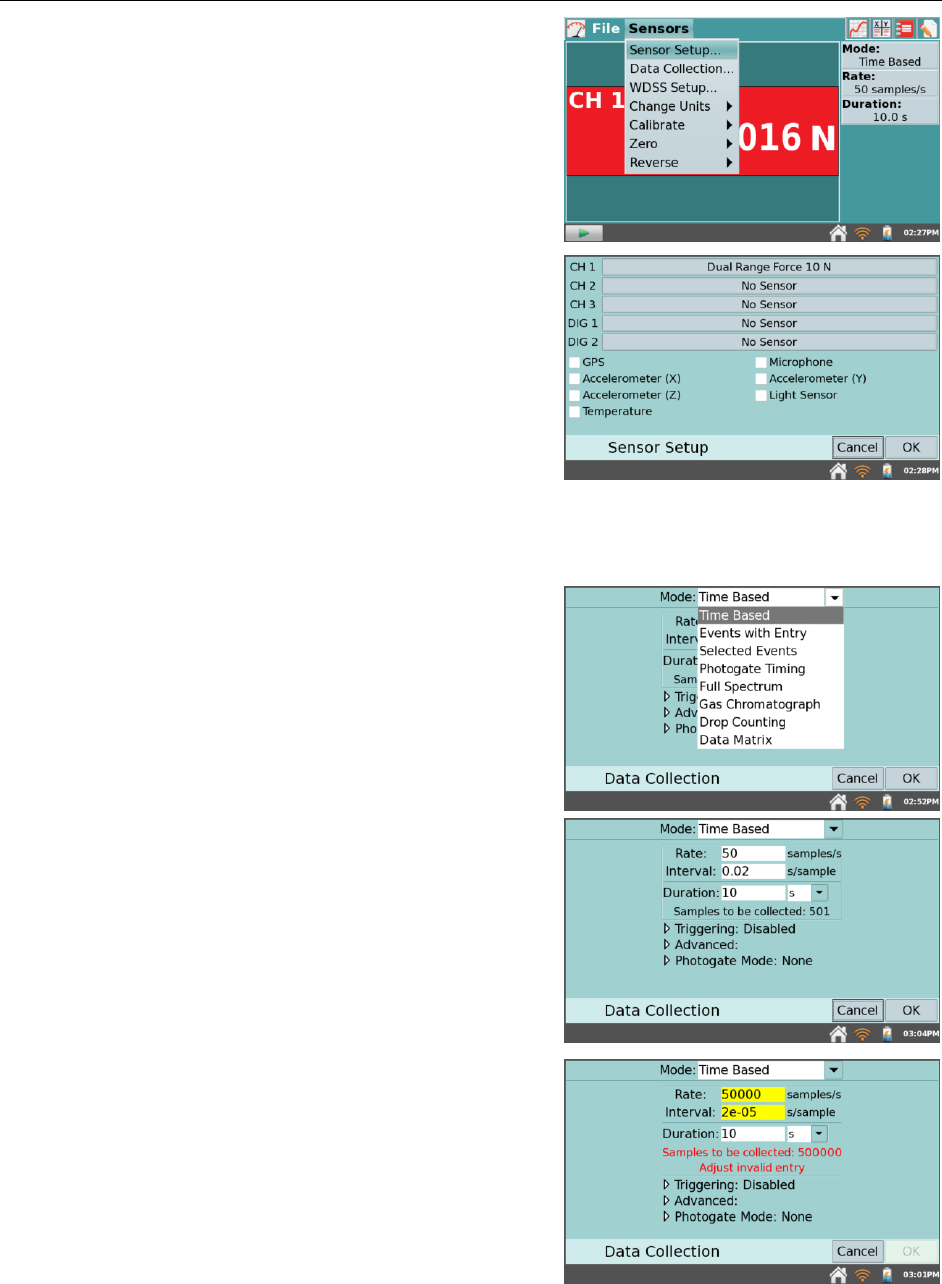
LabQuest App
12
Data-Collection Settings
The Sensors menu gives access to detailed setup
controls. Use this menu to set up the internal sensors,
non-auto-ID sensors, and the Wireless Dynamics Sensor
System (WDSS). You can also use this menu to change
the data collection parameters and specific sensor
settings.
Sensor Setup – Choosing Sensor Setup from the
Sensors menu displays a dialog box showing
which sensors are currently connected. If you
are using a sensor that does not auto-ID, you
will need to manually set up the sensor. To do
this, tap on the field displaying “No Sensor” for
the channel to which your sensor is connected.
In response, LabQuest displays a list of possible
sensors. Tap to select the appropriate sensor.
Then tap OK.
You can also activate (or deactivate) the internal sensors from the Sensor Setup. Check
the box next to the desired sensor to make that sensor available for data collection.
Data Collection – Choosing Data Collection
from the Sensors menu displays allows you to
set the data-collection mode and associated
parameters. The parameters listed will depend
on the mode selected.
o Mode: Time-Based – Time-based data
collection is the default data-collection
mode for most sensors. In this mode,
sensor readings are recorded at regular
time intervals.
Adjustable parameters for this mode
include the rate (or interval) and the
duration of data collection. The total
number of samples to be collected based
on these parameters will be displayed.
Under some circumstances, the Rate and
Duration fields may be highlighted in
yellow or red. The yellow warning
indicates that the rate has been set to
value slower or faster than what is
recommended for the connected sensor,
or that the number of samples could lead
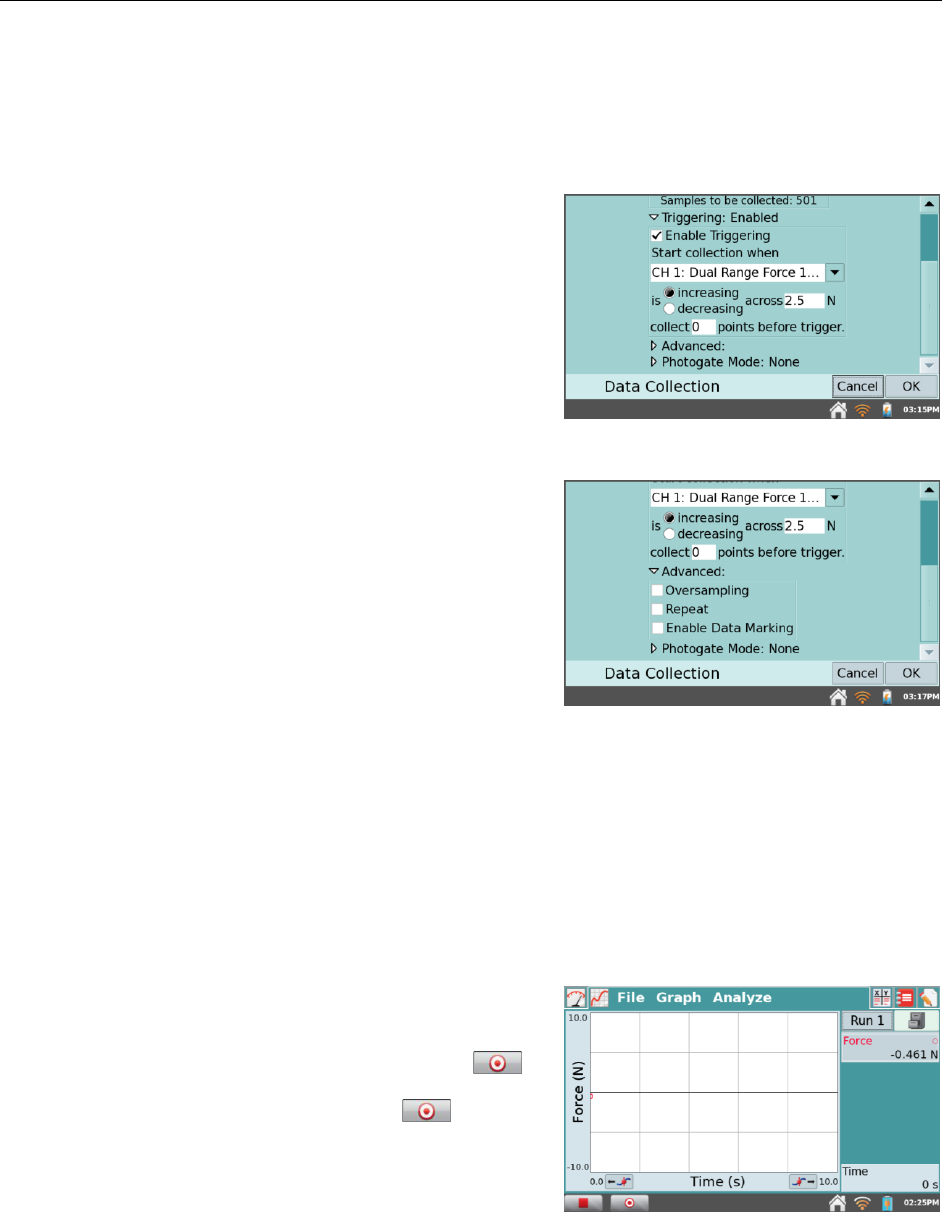
LabQuest App
13
to performance issues. The red warning indicates one of the following: the rate
has been set to a value slower or faster than what a connected device and/or
sensor configuration can support; the number of samples exceeds the storage
available; or, the number of samples exceeds 2000 (for rates faster than 80,000
samples per second).
Triggering – Triggering is only available
in the Time Based mode, and can be
enabled by simply tapping the associated
checkbox. When enabled, LabQuest will
wait for a trigger condition to be met
before beginning data collection. The
sensor name, the level, and the direction
of change (increasing or decreasing) can
all be set here. You can also set the
number of points to be saved before the
trigger condition is met.
Advanced – The Advanced field has
three options that can be independently
enabled by simply tapping the associated
checkbox.
Oversampling can be used with
data-collection rates less than ten
samples per second. When
Oversampling is enabled, the sensor
will sample at a rate higher than the
number of samples per second that
you set, and then LabQuest averages those readings and records the averages
in the data table. This setting can be used to reduce measurement noise by
combining a burst of readings into one value. For example, oversampling can
sometimes reduce the influence of unseen but real variations, such as as those
from a flickering light source.
Repeat can be used with data-collection rates less than 250 samples per
second. When Repeat is enabled, a new data-collection run is started as soon
as the current run has ended. Data for each run is overwritten when a new run
is started. This setting is helpful when doing exploratory investigations.
Enable Data Marking can be used to
mark points of interest during a
time-based data collection. When
enabled, a Mark Data button
will appear when data is being
collected. Simply tap duing
data collection to mark that
particular point as a point of interest.
After completing data collection,
data marks can be named as part of
the analysis process.
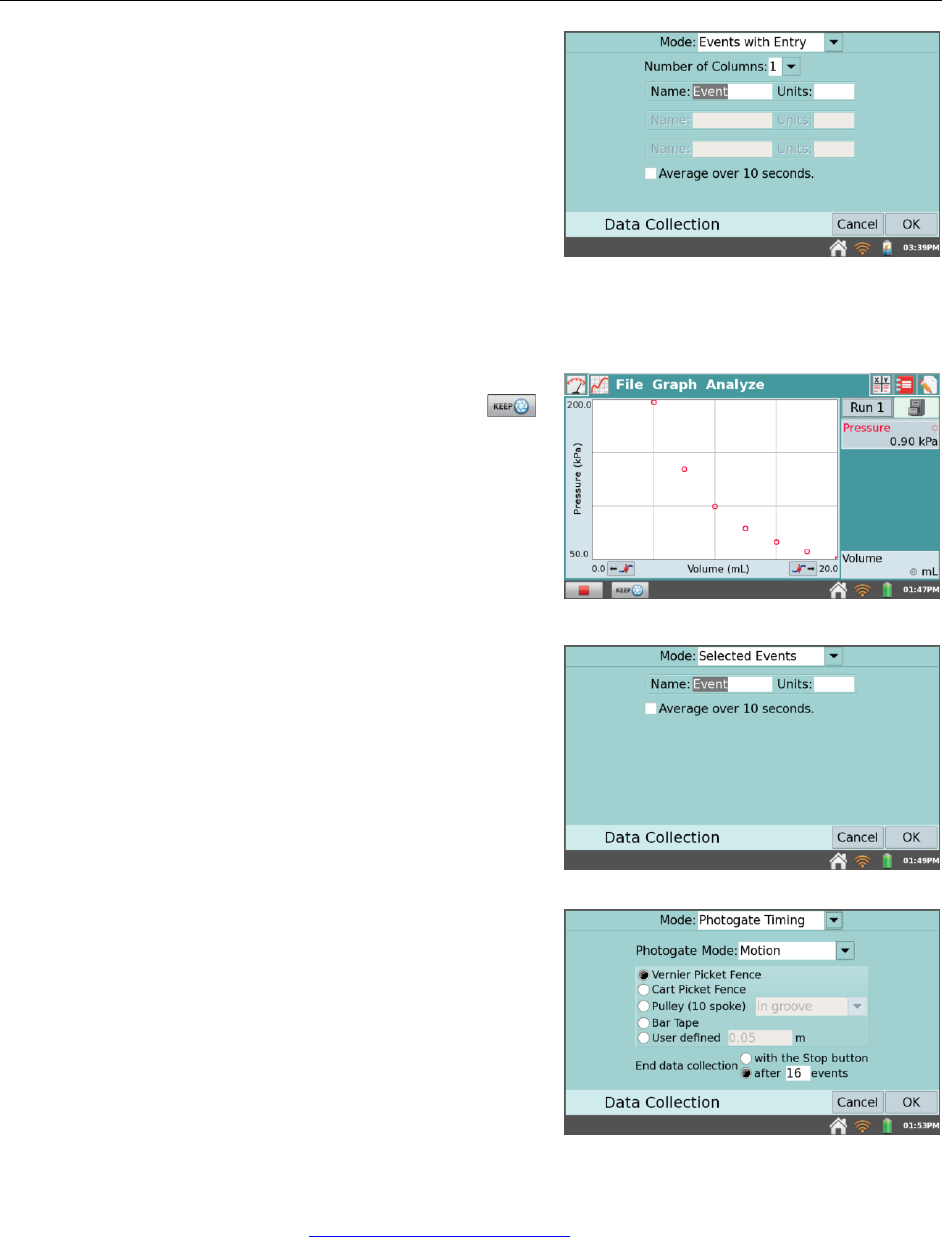
LabQuest App
14
o Mode: Events with Entry – Sometimes
experiments do not depend on time, but
depend on the setting of another
quantity. For example, in a Boyle’s law
experiment one wants to know the
pressure as a function of the volume of
gas. Thus, in Events with Entry mode, no
time information is recorded.
When setting up this mode, you can
enter a name and units for the entry, or independent variable, column. One or two
additional columns of data can be entered as you collect data. You also have an
option to average data over ten seconds and report the averaged reading.
In Events with Entry mode, once data
collection is started, a Keep button
appears. Tap the Keep button to record
the sensor value (e.g., gas pressure in the
Boyle’s law experiment). In response,
LabQuest will prompt for the Entry
value (e.g., gas volume in the Boyle’s
law experiment). Sensor values are
plotted versus the Entry values, as shown
in the screenshot at right.
o Mode: Selected Events – Selected Events
is similar to the Events with Entry mode,
except that entries of 1, 2, 3… are
entered automatically for you. No time
information is recorded in Selected
Events mode.
o Mode: Photogate Timing – Photogates
require a different set of timing options.
When a photogate is detected, LabQuest
switches to the data-collection mode
Photogate Timing mode.
You have two options for ending data
collection in this mode: the collection
runs until the user taps Stop, or the
collection can be set to end after a defined number of events. A block/unblock
pair counts as two events. Various photogate modes are available to set what
parameters LabQuest calculates from the block and unblock times. For more
information, see www.vernier.com/til/1623/
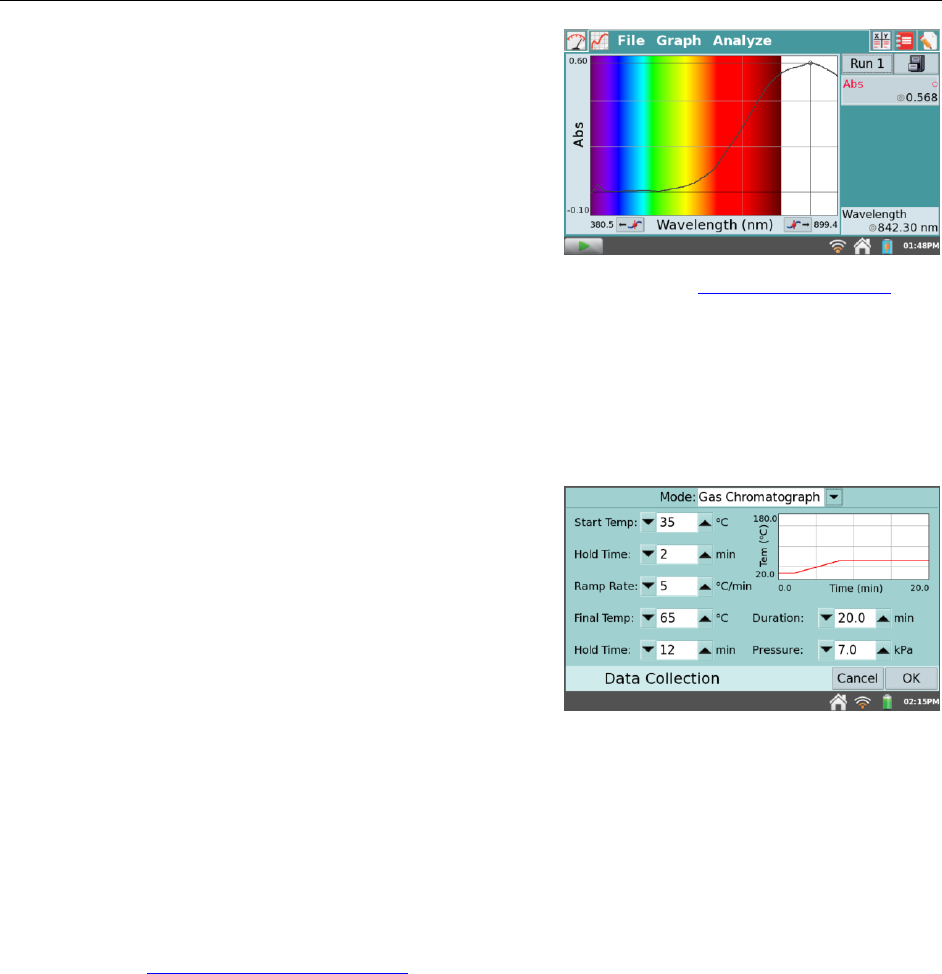
LabQuest App
15
o Mode: Full Spectrum – Full Spectrum
data-collection mode can only be used
with Spectrometers and is the default
mode when a Spectrometer is connected.
In Full Spectrum mode, Intensity,
Absorbance, Fluorescence (SpectroVis
Plus only), or %Transmittance can be
measured as a function of wavelength.
Detailed instructions for setting up data
collection with spectrometers are included in each of our spectrometer labs.
o Mode: Gas Chromatograph – LabQuest 2 supports the use of the Vernier Mini Gas
Chromatograph (GC). When a Mini GC is plugged in the LabQuest 2 USB port,
the software will automatically identify the Mini GC and select the Gas
Chromatograph mode. This mode should not be entered unless a Mini GC is
attached.
In this mode, various parameters are
defined for the user to establish a
temperature and pressure profile
adequate for the current experiment.
When the mode is first entered, a set of
default parameters is displayed. If you
wish to change these parameters, tap in
the parameter field to enter a new value
or adjust the default value by tapping the
arrow buttons. These values will be
reflected in the preview of the time-dependent temperature graph displayed at
right. After setting the parameters, tap OK to initiate the Mini GC warm up.
Note: A new message will appear, “Do not inject until GC is ready.” The
Mini GC will take a few minutes to warm up and stabilize. When the Mini GC is
ready for injection, the message will read, “Inject and select Collect
simultaneously.”
For more detailed information on the Vernier Mini Gas Chromatograph, see
www.vernier.com/gc-mini/
o Mode: Drop Counting – In this mode, you can choose to calibrate drops so that the
volume of titrant is recorded in units of milliliters. Choose Calibrate from the
Sensors menu. The Vernier Drop Counter is set to use a default calibration of 28
drops/mL. If you choose to calibrate the sensor, the volume of an individual drop
will be determined by the number of drops that pass through the Vernier Drop
Counter and dividing by the total volume of the drops. Follow the instructions on
the screen to complete a custom calibration. Alternately, the Equation tab allows
you to input a previously determined value for drops/mL. Enter the drops/mL
value (e.g., 28.0), then choose OK.
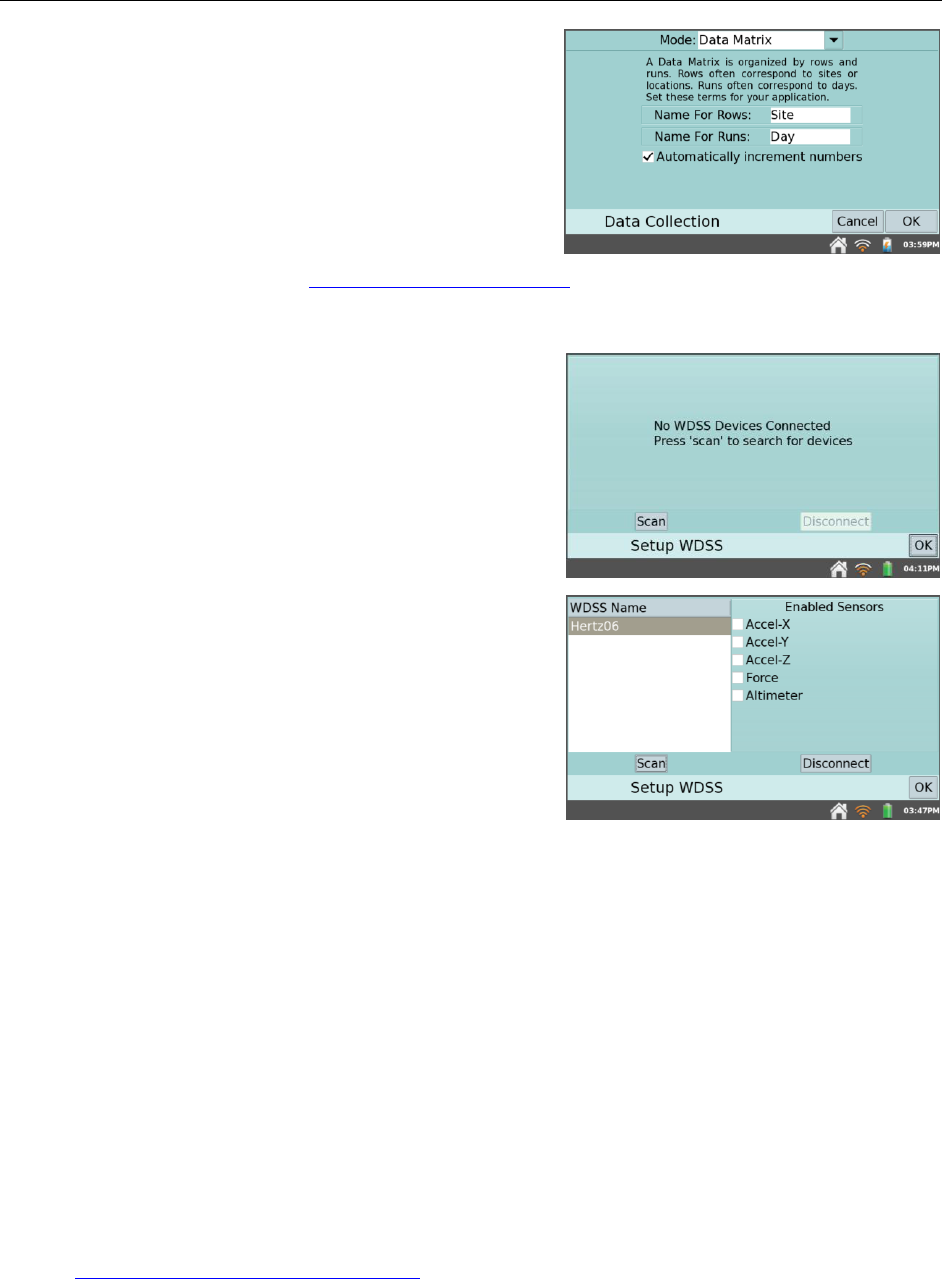
LabQuest App
16
o Mode: Data Matrix – This mode is
primarily used for field work. It provides
a way to collect data referenced to two
parameters such as the locations of the
sampling sites and the dates on which
they were sampled. It also allows you to
collect data from an unlimited number of
sensors by permitting sensors to be
swapped in and out of LabQuest during
data collection. For more detailed
information, see www.vernier.com/til/2366/
WDSS Setup – Selecting WDSS Setup from the
Sensors menu allows you to scan for, select, and
configure Wireless Dynamics Sensor Systems.
You can then choose to scan for any available
WDSS devices. This scan may take some tens of
seconds, and may have to be repeated several
times to find all available WDSS units.
A list of detected WDSS is displayed. Tap to
select the desired WDSS by name and tap OK.
Next, select which of the five sensor channels to
be used (and/or scan for additional WDSS units,
or disconnect from a connected unit). Tap OK to
enable sensors.
Once sensors are enabled, they can be controlled
like other sensors in terms of data collection rate
and duration.
Note: WDSS cannot be set up for remote data collection using LabQuest. Use Logger Pro
on a computer to set up WDSS for remote use.
Change Units – In some cases, you may have the option to display the sensor data in
another set of units. Choosing Change Units from the Sensors menu allows you to select
a different set of units. Choosing a new unit will change all existing runs for that sensor
to the new unit, as well as any subsequent runs. If this feature is grayed-out in the menu,
then the data for that particular sensor cannot be displayed in another set of units.
Calibrate – Most sensors do not need to be calibrated, as a factory calibration for that
sensor is read from the sensor when LabQuest identifies it. However, some sensors do
require calibration and you will use the Calibrate tool accessible from the Sensors menu.
In such cases, follow the detailed calibration instructions provided in the booklet included
with the sensor. Booklets are also available online at:
www.vernier.com/support/manuals/
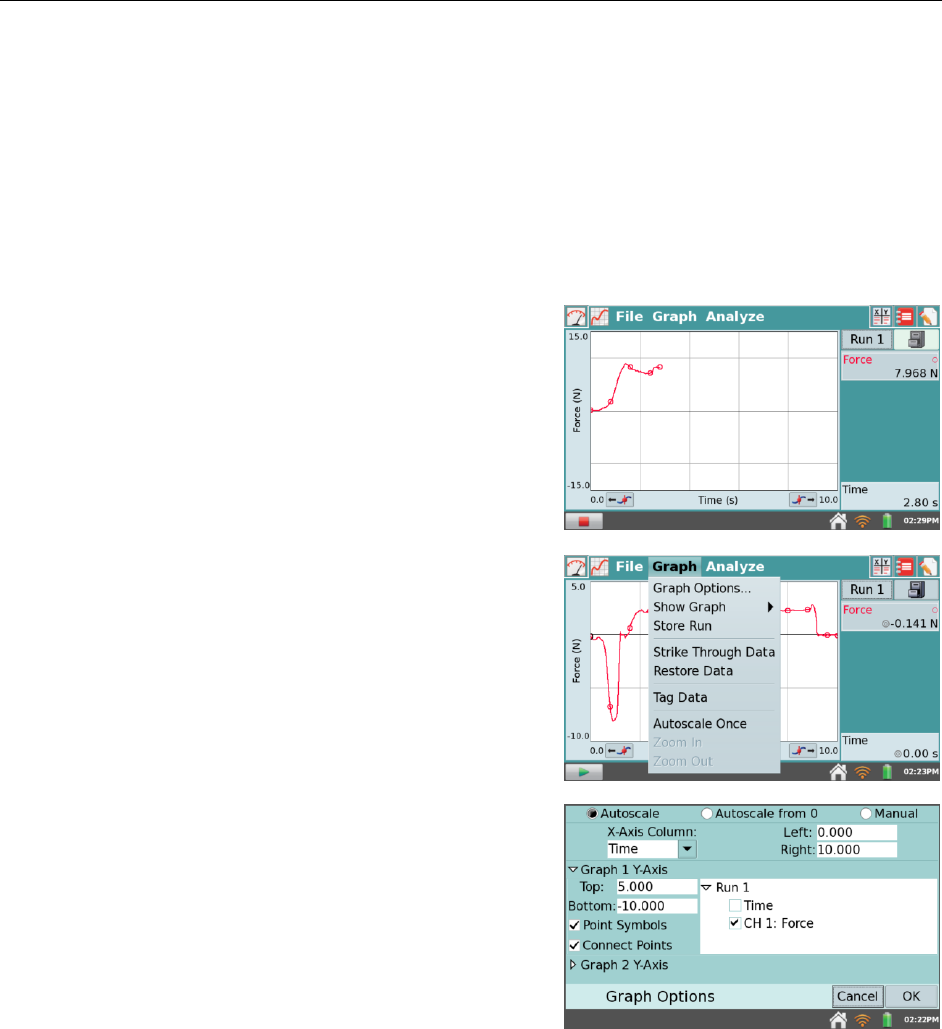
LabQuest App
17
Zero – Choosing Zero from the Sensors menu will set the current sensor reading to zero
by adding an offset to the current reading. Not all sensors can be zeroed.
Reverse –Some sensors read both positive and negative values. For example, the Dual-
Range Force Sensor reads positive values when pulled, and negative when compressed,
be default. Choosing Reverse from the Sensors menu will swap the sign of the readings
with respect to the default settings. Not all sensors can be reversed.
Graph Settings
LabQuest App automatically switches to the Graph
screen when data collection begins. From this screen,
you can adjust graph settings in real-time during data
collection, or after data collection has ended. You can
choose what is plotted, how the graph is scaled, how the
data is formatted, and choose data to ignore by striking
through the values.
Graph Options – To control how the data are
graphed, tap the Graph menu and choose Graph
Options. Here you can choose the columns used
for the x- and y-axes and the axes limits.
Selecting Autoscale will cause the graph range
to adjust to the data range after data collection
ends. Autoscale from 0 does the same, but
includes the origin. Manual scaling will respect
values entered in the range limits, unless
incoming data falls outside the range. In this
case the range will expand to include the data.
To enter range limits, tap in each field and use
the keyboard to enter numeric values.
The Point Symbols option is selected by
default, and will surround some, but not all, of
the points with a circle. This allows easy
identification of a trace by the corresponding
mark in the graph legend. Simply tap the associated checkbox to disable this feature.
The Connect Points option connects data points with straight-line segments. These lines
help the eye follow the data trend, but in some cases are not appropriate. On by default,
unchecking Connect Points will leave only the actual points on the graph.
To specify which columns are being graphed, tap the desired column under the proper
run heading to place a checkmark.
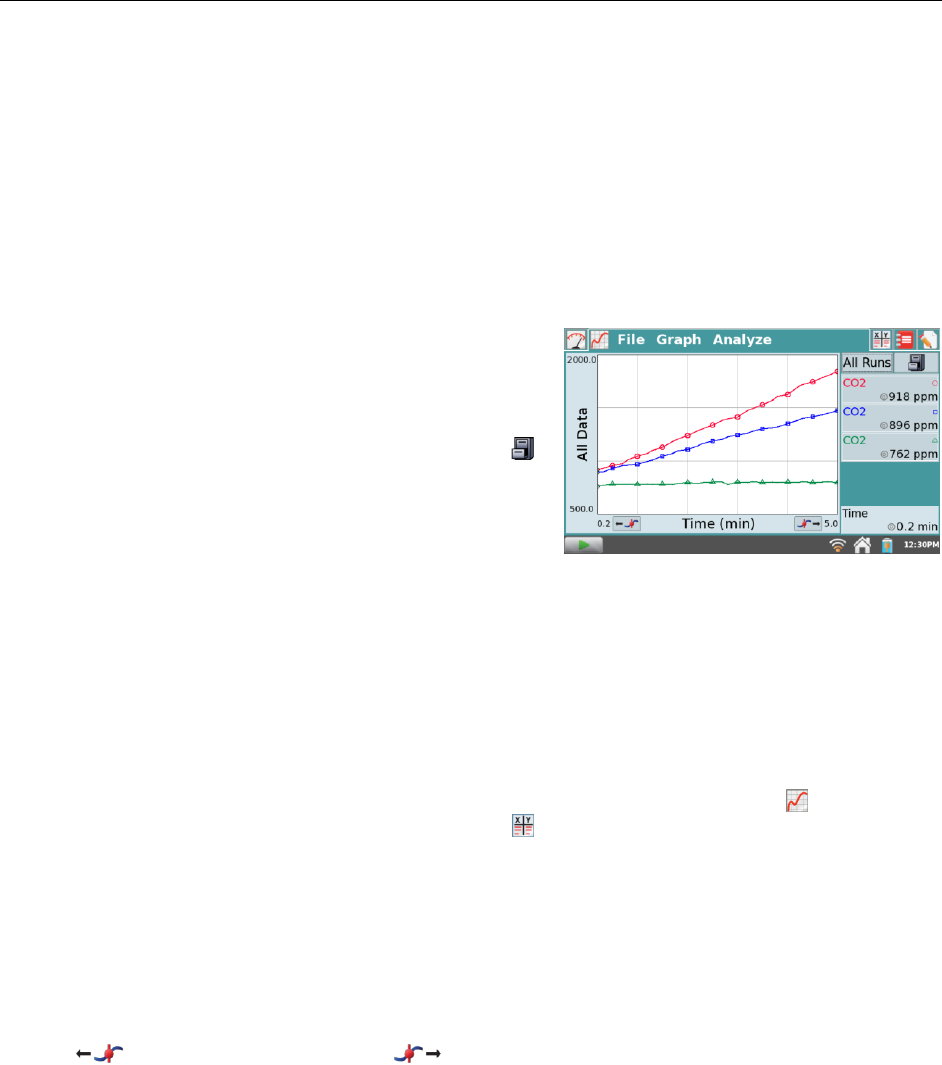
LabQuest App
18
LabQuest can display a single graph, or two graphs. The two graphs share a common x-
axis column and range. Tap the triangle next to Graph 1 Y-Axis or Graph 2 Y-Axis to
show or hide the settings for that axis. If no column is selected for Graph 2, only one
graph will be drawn.
When you are done setting Graph Options, tap OK to return to the Graph screen.
Show Graph – Choosing Show Graph from the Graph menu lets you quickly jump
between displaying one or two graphs. You can also choose the Full Width option, to
remove the data collection summary box and maximize the graphs on the screen.
Store Run – You can collect several runs for
comparison. Choosing Store Run from the
Graph menu allows you to save the current run,
and then proceed with more data collection. As a
shortcut, you can simply tap the File Cabinet .
Collect another run by tapping the Collect
button. Your new run is displayed on the graph.
To see your first run, tap the Run 2 button to the
left of the Filing Cabinet, and select either Run 1 or All Runs. In this way, you can gather
multiple runs for comparison, and view just the ones you want.
Data Analysis
In addition to data collection, LabQuest App also allows you to analyze the data within
LabQuest.
Data can be analyzed from the Graph screen, selectable by tapping the Graph tab , as well as
the Table screen, selectable by tapping the Table tab . Several common analysis features are
described in greater detail, below.
Examining Data on the Graph Screen
To examine data from the Graph screen, tap on a data point of interest. The Examine cursor
jumps to the data point with the nearest x-value to that which you tapped. Cursor lines highlight
the x- and y-axis values, and the right-side readouts display the associated numerical values of
the point. You can make fine adjustments to the cursor location by using the Left Examine
Button and Right Examine Button located on either side of the horizontal-axis label.
In some cases, you may want to examine data for a particular region on the graph. To select a
portion for analysis, simply tap and drag across the desired region. You can adjust the trailing
endpoint of the selected region using the Examine Buttons, if needed. Or, for greater control, you
can optionally use the stylus.
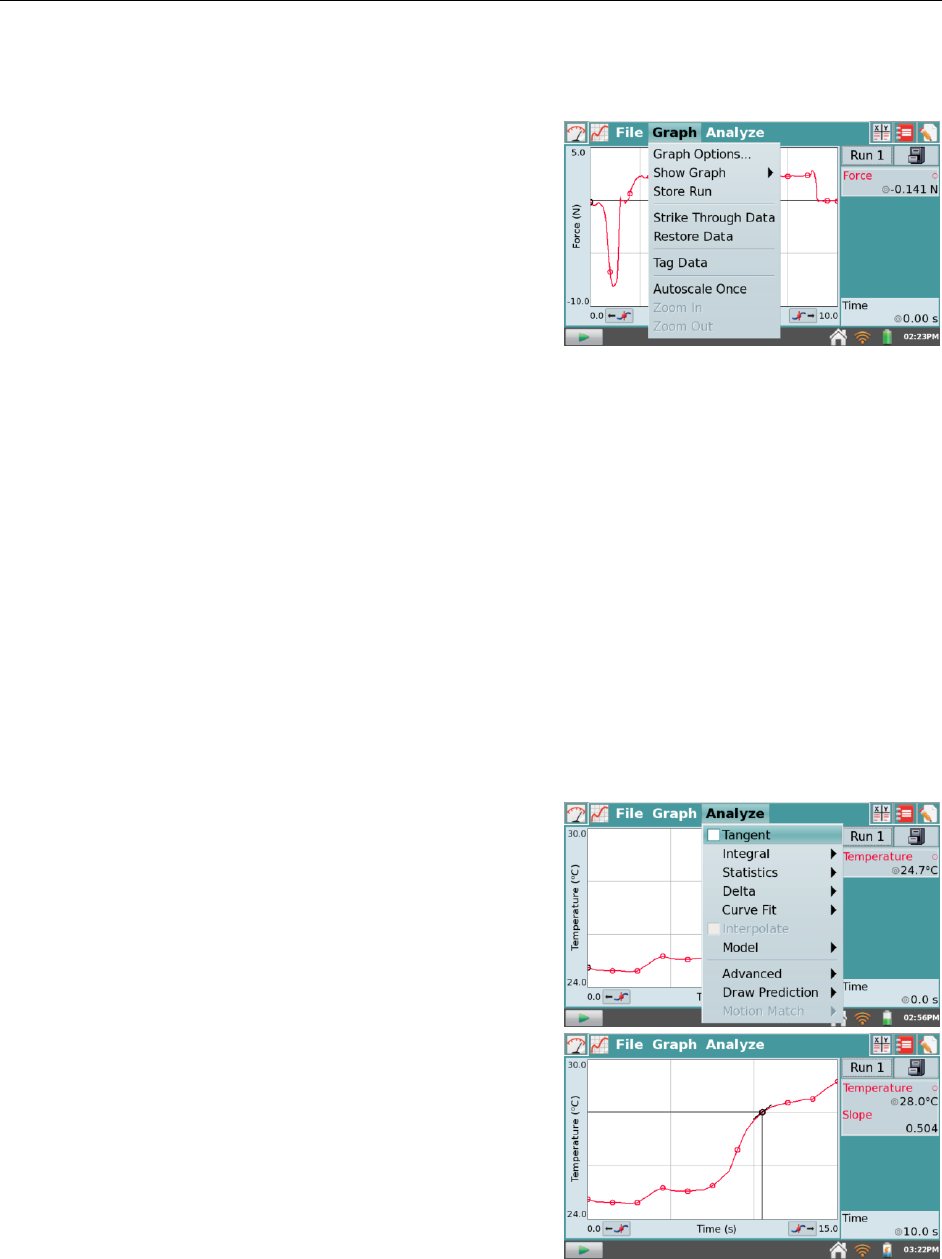
LabQuest App
19
Adjusting the Graph View
You can adjust the graph view in real time during data collection, or after data collection has
ended, by applying one of the following actions from the Graph menu.
Autoscale Once – Tap Autoscale Once will
quickly reset the axes of the currently selected
graph based on the data. It is an easy way to
automatically scale both axes.
Zoom In – Select a region on the graph, then tap
Zoom In to automatically adjust the axes for
viewing the selected region.
Zoom Out –Tap Zoom Out to undo a Zoom In
and return the graph axes to the previous
settings. If Zoom In is used several times, Zoom Out will undo each Zoom In, one at a
time.
Graph Options – Tap Graph Options to manually adjust graph settings. To adjust the
graph view, change the values in the Left and Right fields for the x-axis and y-axis.
Manipulating Data from the Graph Screen
You can manipulate data from the Graph screen or from the Table screen. If using the Graph
screen, first tap to select a data point of interest or tap-and-drag to select a region of data. Then,
choose the desired tool from the Graph menu. Upon tapping on the tool, the action will be
applied to the data.
Strike Through Data and Restore Data – Use these tools to ignore/restore selected data.
Struck data are ignored for analysis and graphing, and the graph will update accordingly.
To restore all data, tap the Graph menu and choose Restore Data.
Tag Data – Use this tool to tag a data point with a comment. After selecting the point and
tapping Tag Data, a circle will be displayed on the graph to “tag” the data. To add a
comment, tap in the info box at the right and enter a comment into the blank field.
Analyzing Data from the Graph Screen
The Analyze menu on the Graph Screen gives you
access to additional tools such as tangent lines,
integrals, statistics, and curve fits. To apply one of these
tools, tap the Analyze menu and tap to select the desired
tool. If prompted, select a column or data set to which
the analysis will be applied.
Upon enabling an analysis tool, a summary of analysis
information is displayed at the right. Scroll arrows will
appear, if needed. Optionally tap the summary to
display the values on a detail dialog for ease of reading.
The following analysis tools are available from the
Analyze menu.
Tangent – The Tangent mode enhances the
Examine cursor by adding a tangent line and
numeric display of the slope as you tap different locations on the graph.
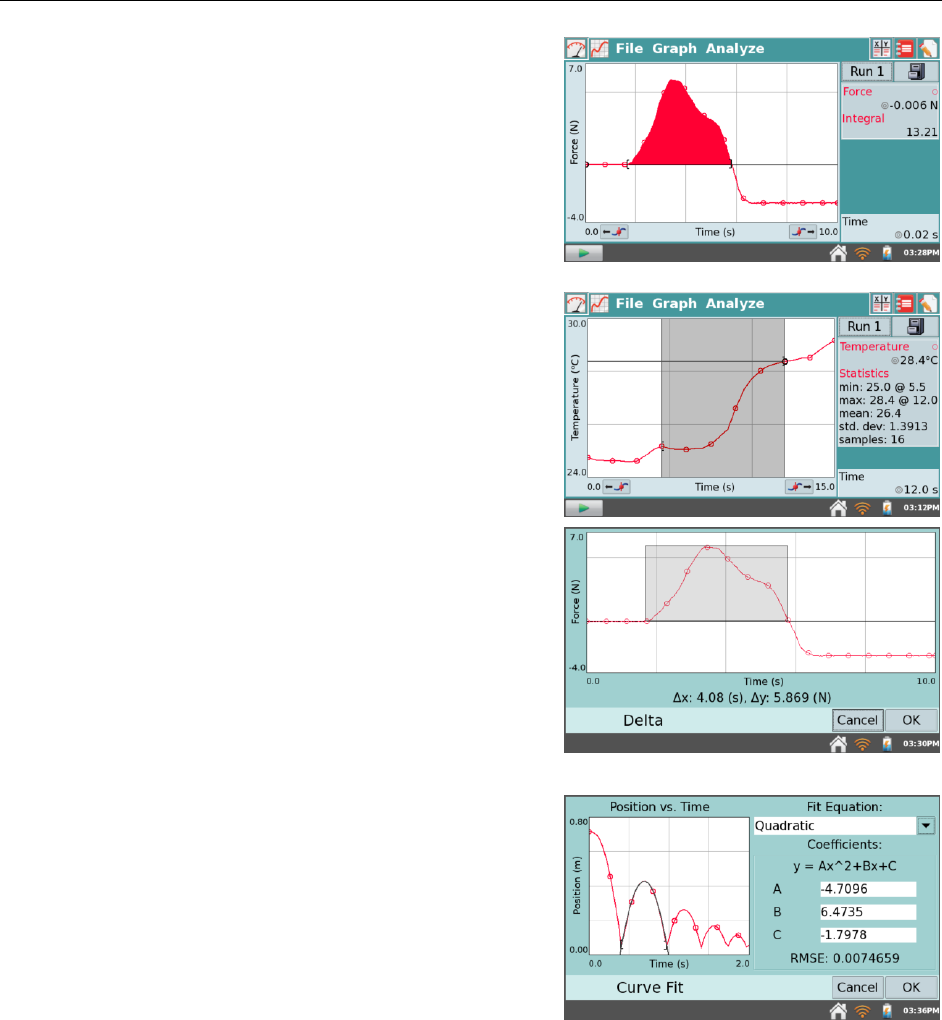
LabQuest App
20
Integral – The Integral tool numerically
integrates graphed data. Select a region, if
needed, then choose Integral from the Analyze
menu. Enable the tool by tapping on the
displayed sensor or column name. The integral
will be drawn, and the numeric result will be
displayed to the right of the graph.
Statistics – The Statistics tool displays statistics
for graphed data. Select a region, if needed, and
then choose Statistics from the Analyze menu.
Enable the tool by tapping on the displayed
sensor or column name. Descriptive statistics
will be displayed to the right of the graph. If a
region is selected, brackets are drawn to indicate
the region used for calculations
Delta – The Delta tool opens a preview window
where you can examine x- and y-deltas. Choose
Delta from the Analyze menu to open the
preview window. Then tap-and-drag to create a
box overlaid on the graph. The vertical side of
the box yields y, and the horizontal side of the
box yields x. Tap OK to keep these values and
display the box on the Graph screen. To exit the
Delta tool without displaying the box on the
Graph screen, tap Cancel.
Curve Fit – The Curve Fit tool allows you to
automatically fit a chosen function to your data.
If a region of the graph is selected, only that
region is used for fitting. If there is no selection,
the entire graph is used.
Enabling the curve fit displays a Curve Fit
dialog box. Choose the desired fit equation from
the drop-down menu. Upon choosing the fit
equation, LabQuest will display the fit in the
preview graph at left. The fit coefficients and Root Mean Square Error (RMSE) are also
displayed. Tap OK to keep this fit and display the curve on the Graph screen. To exit the
Curve Fit tool without applying the curve, tap Cancel.
Tip: The RMSE (root mean square error) is a measure of how well the fit matches the
data. The smaller the RMSE, the closer the data are to the fitted line. The RMSE has the
same units as the y-axis data.
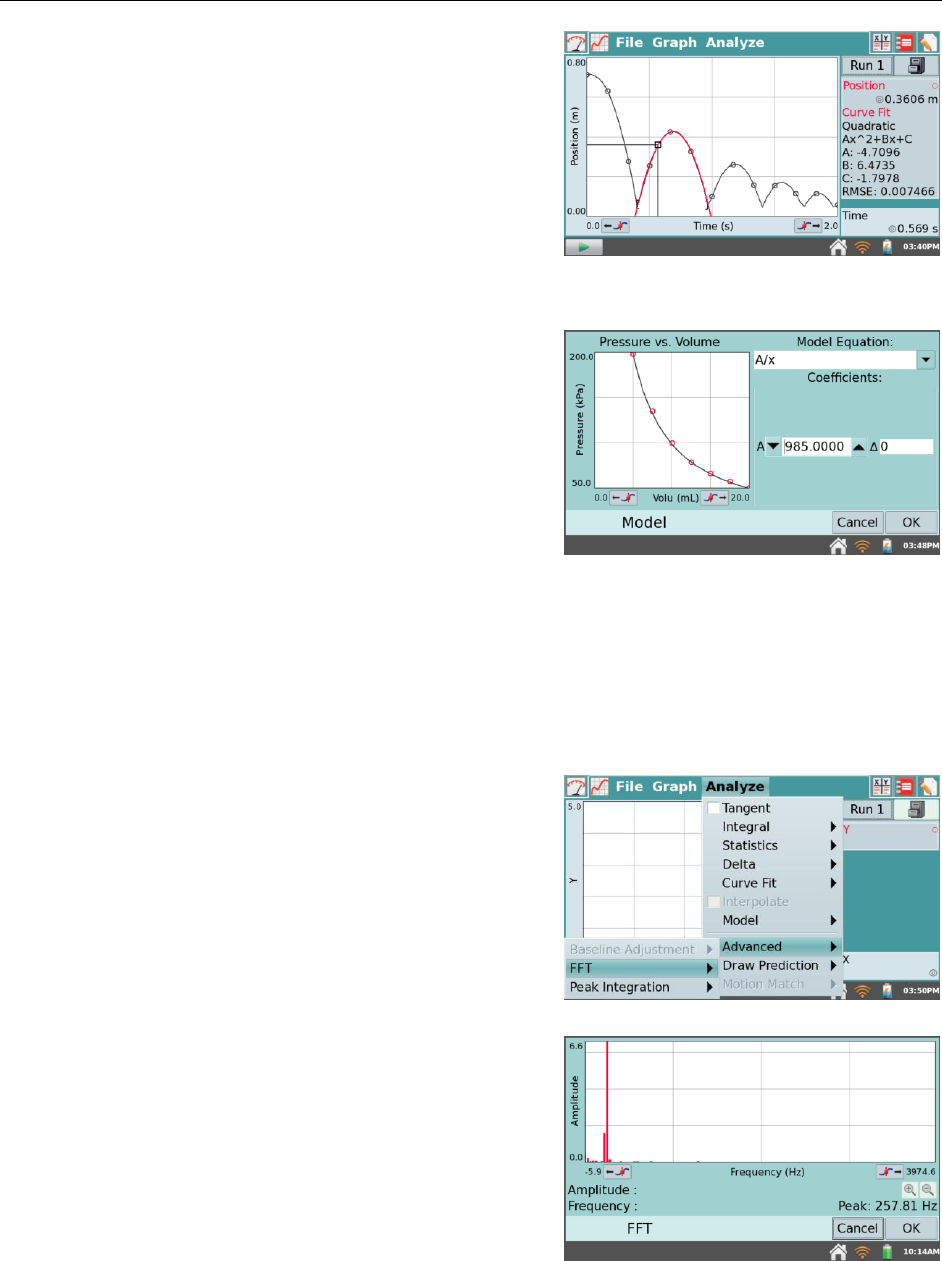
LabQuest App
21
Interpolate – Once you have performed a curve
fit, you can use the Interpolate function to read
values off of the fitted function. Choose
Interpolate from the Analyze menu to enable the
tool, then tap on the graph. The lines associated
with the Examine cursor now locate a position
on the fitted function, and coordinates along the
fitted line are shown in the summary box at the
right of the graph. You can tell that LabQuest is
in the Interpolation mode by the square cursor
shown at the Examine point.
Model –Model allows you to manually fit a
chosen function to your data. Enabling the
Model tool displays a Model dialog box where
you can choose the desired model equation from
the drop-down menu.
The model parameters (e.g., A, B and C) are
adjustable. Change them by direct entry or by
using the up and down arrows. Upon choosing
the equation, LabQuest will display the modeled
function in the preview graph at left. Tap OK to keep this function and display the
modeled function on the Graph screen. To exit the Model tool without applying the
function, tap Cancel.
Tip: If no function appears when modeling, your parameters are defining a curve that is
outside of the plot window.
Advanced – Choosing Advanced from the
Analyze menu allows you to access advanced
analysis tools including Baseline Adjustment,
Fast Fourier Transform (FFT), and Peak
Integration.
o Baseline Adjustment – This tool applies
a factor that raises or lowers the x-axis.
Because the LabQuest App uses the x-
axis as its baseline when calculating an
integral, adjusting the baseline may
result in a better integral.
o FFT – The FFT tool calculates a Fast
Fourier Transform of the selected data.
The FFT is displayed in a special graph
that can be analyzed. Tap OK to return to
the main graph. The peak frequency will
be displayed on the graph legend..
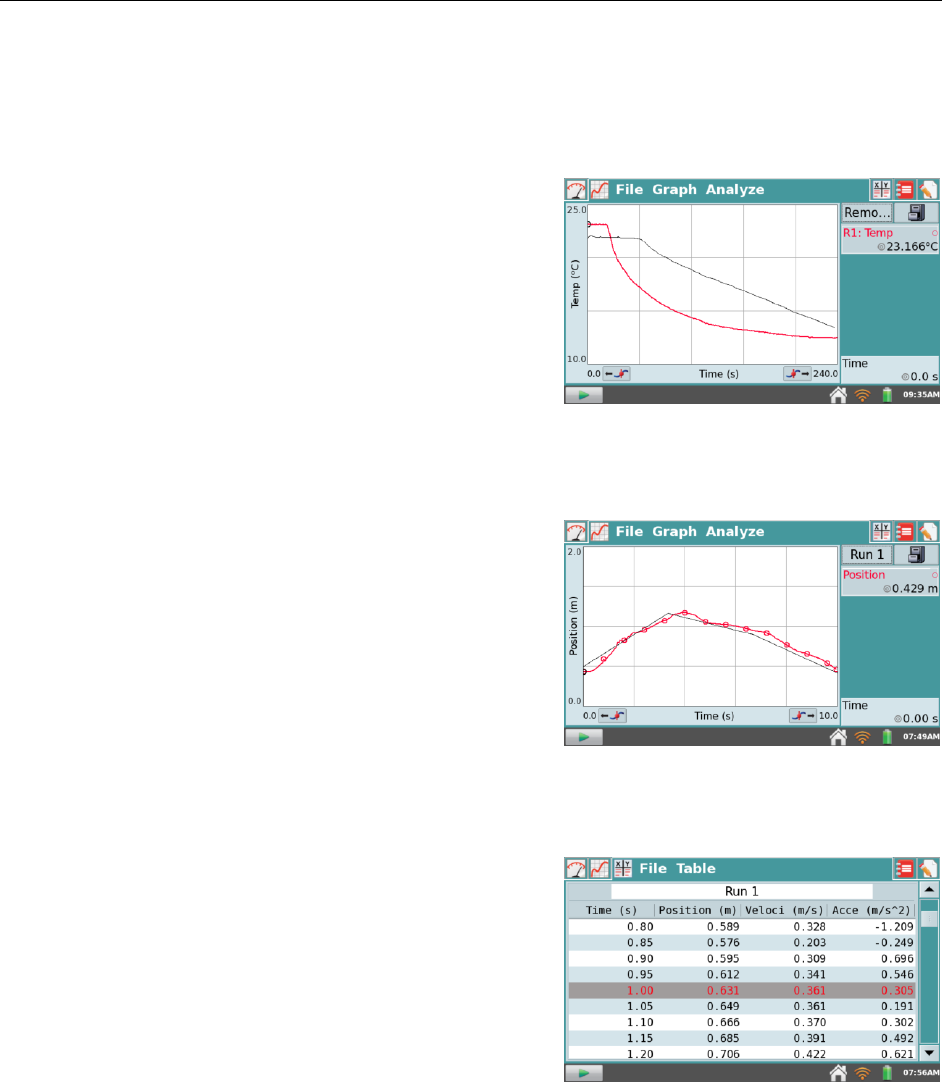
LabQuest App
22
o Peak Integration – This option calculates the integral for a selected portion of a
graph. It is most commonly used with the Vernier Mini GC, but it can be applied
to any data plot. Peak Integration differs from the Integral tool in that it does not
use the x-axis as the baseline. Instead, the integral for Peak Integration is
evaluated from the minimum y-values to the left and right of a selected peak.
Draw Prediction – The Draw Prediction tool
gives you a free-hand sketch tool for drawing on
the Graph screen. This can be used for a variety
of purposes, but is most often used to sketch a
prediction of how a graph will appear once data
are subsequently collected.
Upon enabling this tool, tap-and-drag across the
screen for smooth curves, or tap the screen to
connect subsequent taps with straight-line segments. The Reset button will remove your
sketch if you need to start over. Tap OK to place your sketch on the main graph. To
remove a prediction, choose Draw Prediction again from the Analyze menu.
Motion Match – The Motion Match menu item is
only available if a Motion Detector is connected.
You have a choice of a new Position or Velocity
match. In each case LabQuest generates a
random target graph for matching exercises.
Only the selected graph, Position or Velocity, is
shown in match mode. You may collect data
over the target graph as many times as you like.
To see a new target graph, choose New Position
Match or New Velocity Match again. Remove
Match removes the target graph.
Adjusting the Table View
In addition to viewing and manipulating data from the
Graph screen, you can also work with the data from the
Table screen. Tap the Table tab to change to the Table
screen. There are several shortcuts on this screen.
Alternatively, you can also access the fields by choose
Data Column Options from the Table menu.
Tap Run 1 in the name field to rename the run.
Tap a column header (Time, Position, etc.) to
change the column name, units, or displayed
precision.
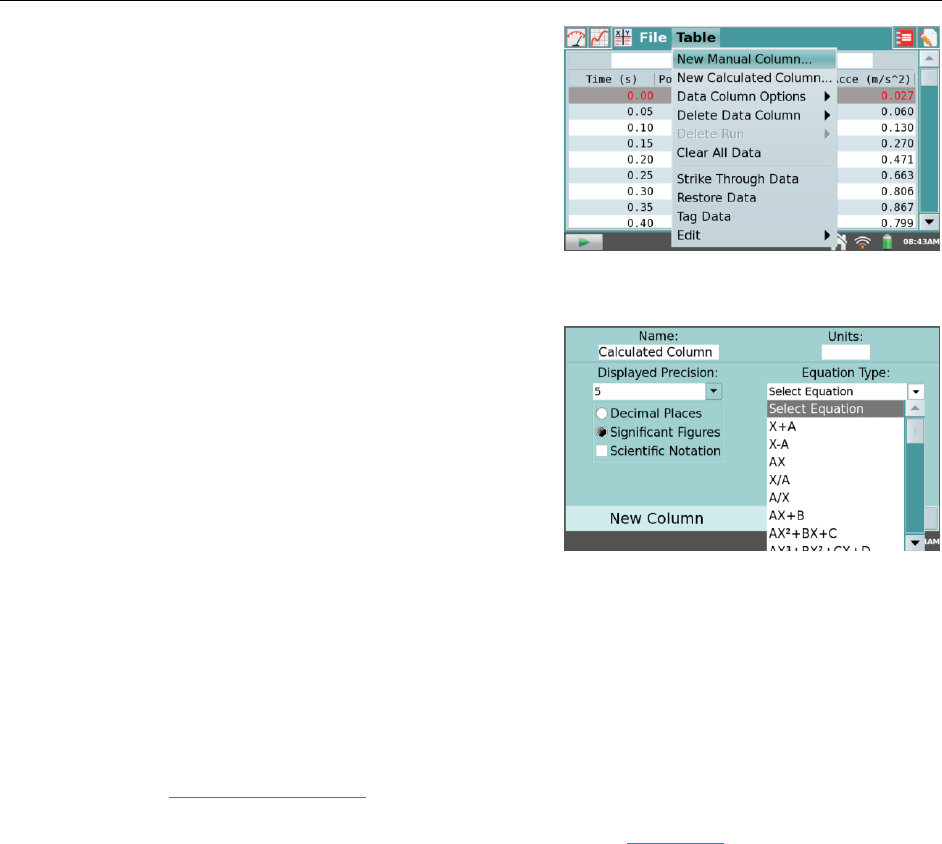
LabQuest App
23
Manipulating Data from the Table Screen
The Table menu allows you to create, modify, or delete
columns of data. Anything in columns can be graphed.
The following tools are available from the Analyze
menu:
New Manual Column –New Manual Column
creates an empty column into which you can
enter or generate values directly. Tip: To make a
graph of data from other sources, enter values in two manual columns, and then plot
them in a LabQuest graph.
New Calculated Column –New Calculated
Column creates a new column whose values are
based on other columns by a mathematical
formula. Tap the Name field to enter a name for
the new column, tap the units field to enter the
units, then tap the Equation Type field and
choose an equation for the calculations in this
column. For example, you might define a
calculated column as the inverse square of
another column. After creating a calculated
column, you can display the calculated data on a graph, or manipulate it further with
additional calculated columns.
Data Column Options – This allows you to access the fields for setting the column name,
units, and displayed precision. Alternatively, you can access these fields by simply
tapping on the column name from the Table screen.
Delete Data Column – This allows you to delete a manual or calculated column of data.
Note that you cannot delete data collected from a sensor; however, you can hide data
using the Strike Through Data tool.
Delete Run – If you have stored at least one run using the Store Run tool, this option will
be selectable from the Table menu. Upon choosing Delete Run, tap the desired run name
to delete the run. You will not be able to delete the last run created.
Clear All Data – This action will clear all data in the table. Upon choosing this option, you
will be prompted to confirm.
Strike Through Data and Restore Data – Use these tools to ignore/restore selected data.
Struck data are ignored for analysis and graphing, and the graph will update accordingly.
To restore all data, tap the Table menu and choose Restore Data. Note that you can also
access these tools from the graph screen by tapping on the Graph menu.
Tag Data – Use this tool to tag a data point with a comment. After selecting the point
within the table and tapping Tag Data, a circle will be displayed on the graph screen to
“tag” the data. To add a comment, tap to select the Graph tab, locate the tagged point and
tap to place the Examine cursor at this point. Then tap the info box at the right and enter a
comment into the blank field.
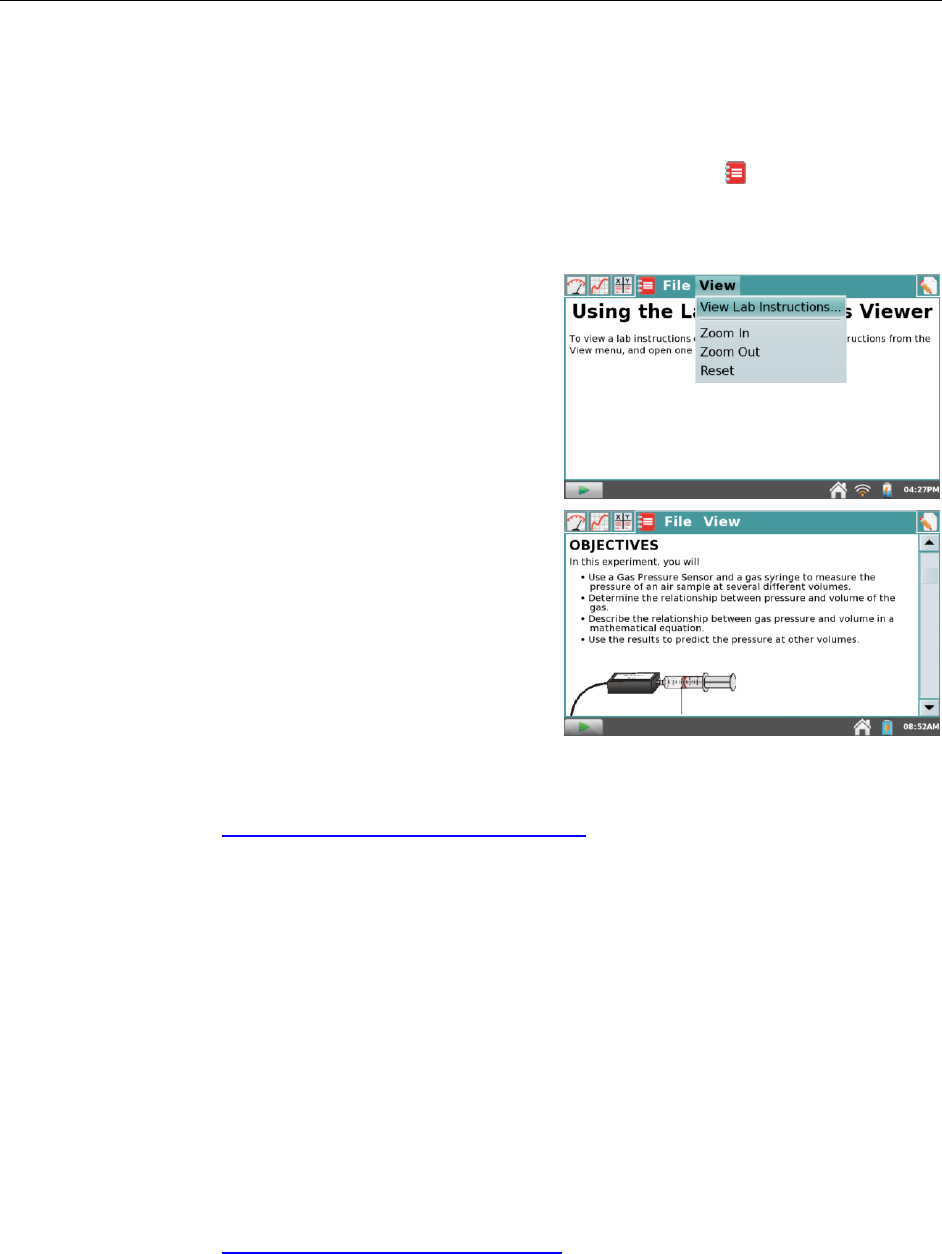
LabQuest App
24
Edit – This tool allows you to copy and paste values from one place to another. In
particular, you might copy a range of values and paste them into notes on the Notes
screen.
Viewing Vernier Lab Instructions
The Lab Instructions screen, selectable by tapping the Lab Instructions tab , allows students to
view lab instructions from Vernier lab books. LabQuest comes preloaded with over 100 labs.
You can easily download labs from other books that you have purchased and load them onto
LabQuest using our easy-to-use web tool, LabQuest Organizer. You can also create new content
using our online LabQuest Creator.
Opening Vernier Lab Insructions
From the View screen, choose View Lab Instructions
from the View menu. This displays a list of the lab
books with labs preloaded on LabQuest. Tap on the
desired book, tap OK, then choose the desired lab and
tap OK.
In addition to scrolling through the instructions using
the scrollbar at right, you can also zoom in on a
particular portion of the instructions by selecting Zoom
In from the View menu. Selecting Zoom Out from the
View menu restores the previous view. Selecting Reset
from the View menu restores the original view.
Adding Labs to LabQuest
If you have purchased Vernier lab books and have labs
in your books that you would like to load onto LabQuest, you can do so using our online tool,
LabQuest Organizer. Follow these simple instructions:
1. Visit our web site: www.vernier.com/labquest/organizer/
2. Select the labs that you wish to add. (Note that you can either select individual labs or add
entire books)
3. Follow the on-screen guide to create and download a LabQuest Library update and save it to
a USB flash drive or SD card.
4. Follow the provided instructions to transfer the update from the flash drive or SD card to
your LabQuest units.
Creating Your Own Labs
If you would like to create your own lab content, you can do so using our online tool, LabQuest
Creator.
Follow these simple instructions:
1. Visit our web site: www.vernier.com/labquest/creator/
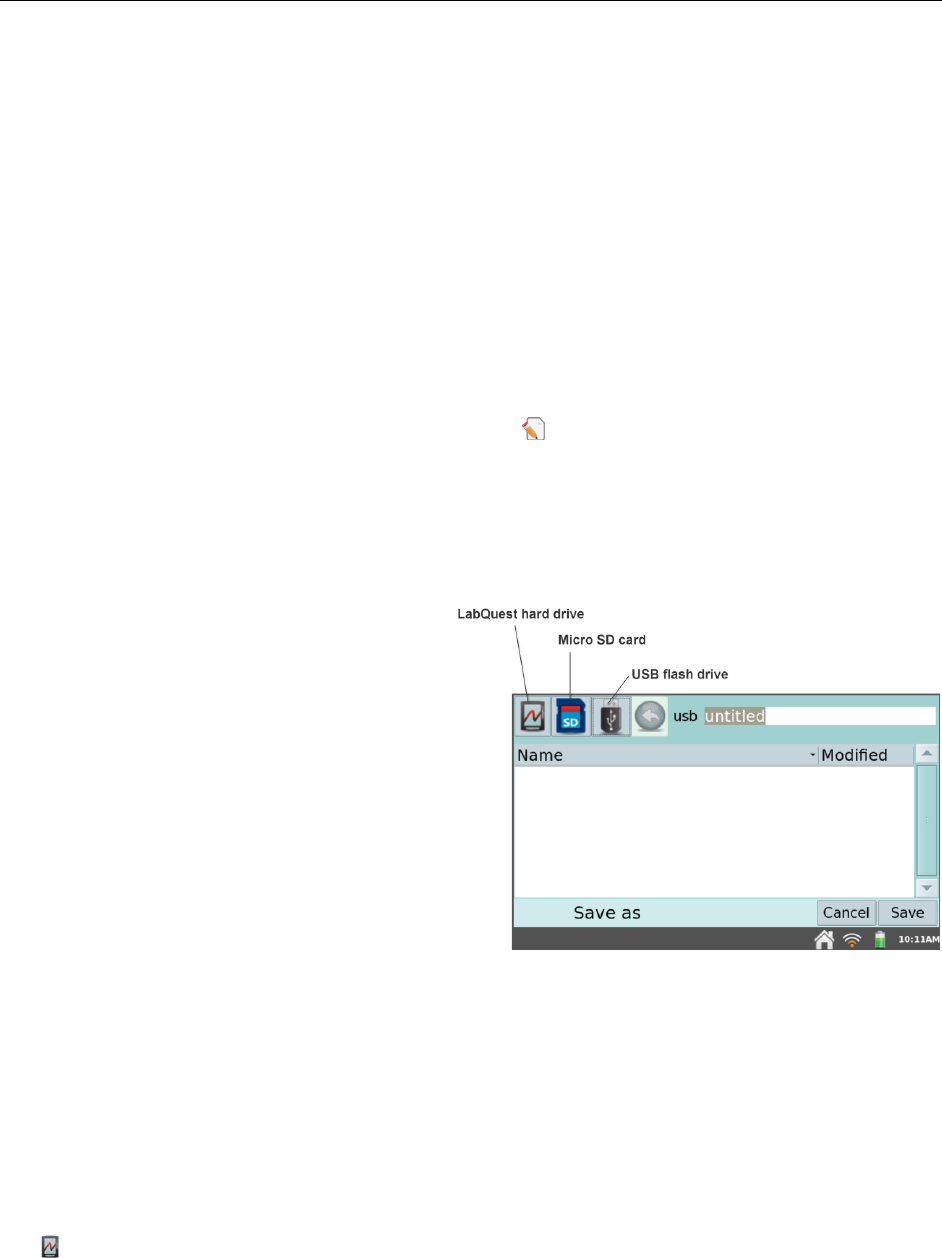
LabQuest App
25
2. Choose your starting point. You can create a new lab from scratch, start with a template, or
paste an existing lab into our Lab Creator.
3. Follow the on-screen guide to create your content. Note that you can save your content and
finish another time. Simply click Save, and a web link will be displayed which you can click
on and then bookmark from your browser for later access.
4. When your content is complete, follow the on-screen guide to preview, name, and download
your lab to a USB flash drive or SD card.
5. Follow the provided instructions to transfer the update from the flash drive or SD card to
your LabQuest units.
Adding Notes to Your Experiment
The Notes screen, selectable by tapping the Notes tab , allows students to enter notes as they
perform an experiment. The menu gives access to standard edit commands of Cut, Copy, Paste,
and Clear All.
Storing LabQuest App Files
LabQuest files have a .qmbl extension and
can be saved to the internal storage space on
LabQuest, or to an external storage space
such as a thumb drive. LabQuest App files
can also be opened and manipulated on a
computer with our Logger Pro software.
LabQuest will recognize additional storage
space in a connected micro SD (Secure
Digital) card or a USB flash drive. The
drive or card may be formatted in FAT16 or
FAT32 (the most common Windows and
Mac OS formats) for reading and writing.
LabQuest cannot read NTFS- or HFS+-
formatted drives.
To save a LabQuest App file,
1. If saving to a micro SD card or USB flash drive, make sure the drive is inserted in the
appropriate port on LabQuest. Note: After inserting the drive wait a few seconds while
LabQuest recognizes the drive before proceeding.
2. Choose Save from the File menu. This opens a Save As dialog box.
3. Tap on the appropriate icon to select your storage destination.
- LabQuest internal hard drive
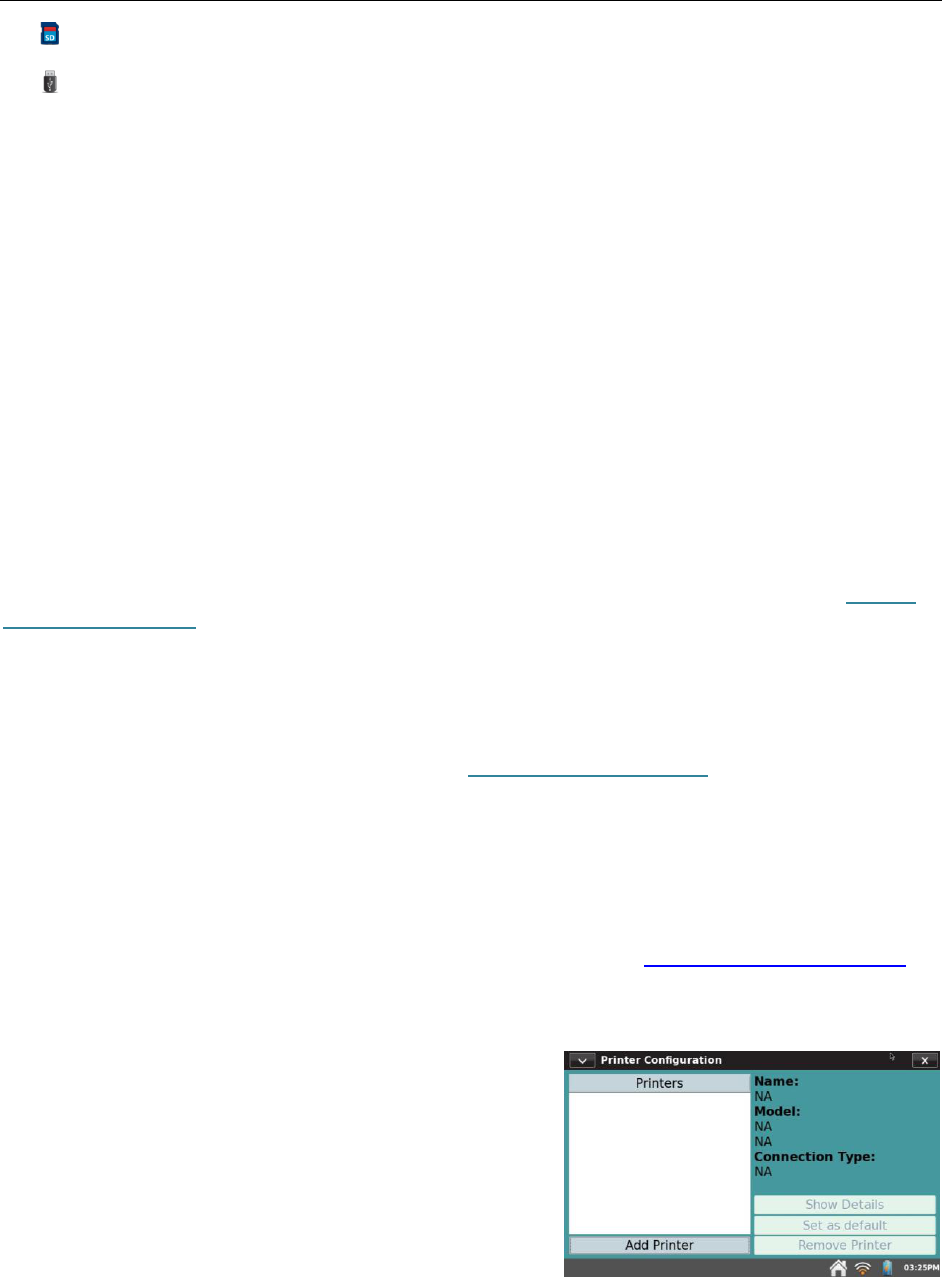
LabQuest App
26
- Micro SD card
- USB flash drive (thumb drive)
4. After selecting your destination, tap on the name field to pull up the keyboard. Then enter the
file name.
5. Tap OK to return to the Save As screen.
6. Tap Save to save the file.
Note: You cannot create directories within LabQuest App, but you can use directories that
already exist on the SD card or USB drive. We recommend organizing your files on a USB drive
or SD card by creating any needed folders on a computer before you use the drive or card with
LabQuest.
Exporting LabQuest App files
In some cases, you may wish to export the LabQuest App file in a text format (.txt) for further
analysis within a program other than Logger Pro.
To do this, select Export from the File menu. Follow steps similar to those described in Storing
LabQuest App Files and choose Export from the File menu instead of Save As.
To open the file in a spreadsheet program, be sure the program’s file browser is set to look for all
files. Select your text file, then
If you have access to a wireless network with Internet, you can email the data file, graph, text
file, or screenshot. For detailed instructions, see Emailing from LabQuest.
Printing from LabQuest App
You may choose to print the graph, data table, lab instructions, your own notes, or the screen as
it is currently displayed in LabQuest App. LabQuest can print to a compatible printer via a USB
cable or via a Wi-Fi network. For a list of compatible printers see: www.vernier.com/til/1659/
USB Printing
For printing to a USB printer for the first time, simply
connect a compatible printer to the full-size USB port
on LabQuest, and turn on the printer.
1. Tap the Home icon at the bottom of the screen, tap
Preferences, and then tap Printers.
2. Tap the Add Printer button on the Printer
Configuration screen.
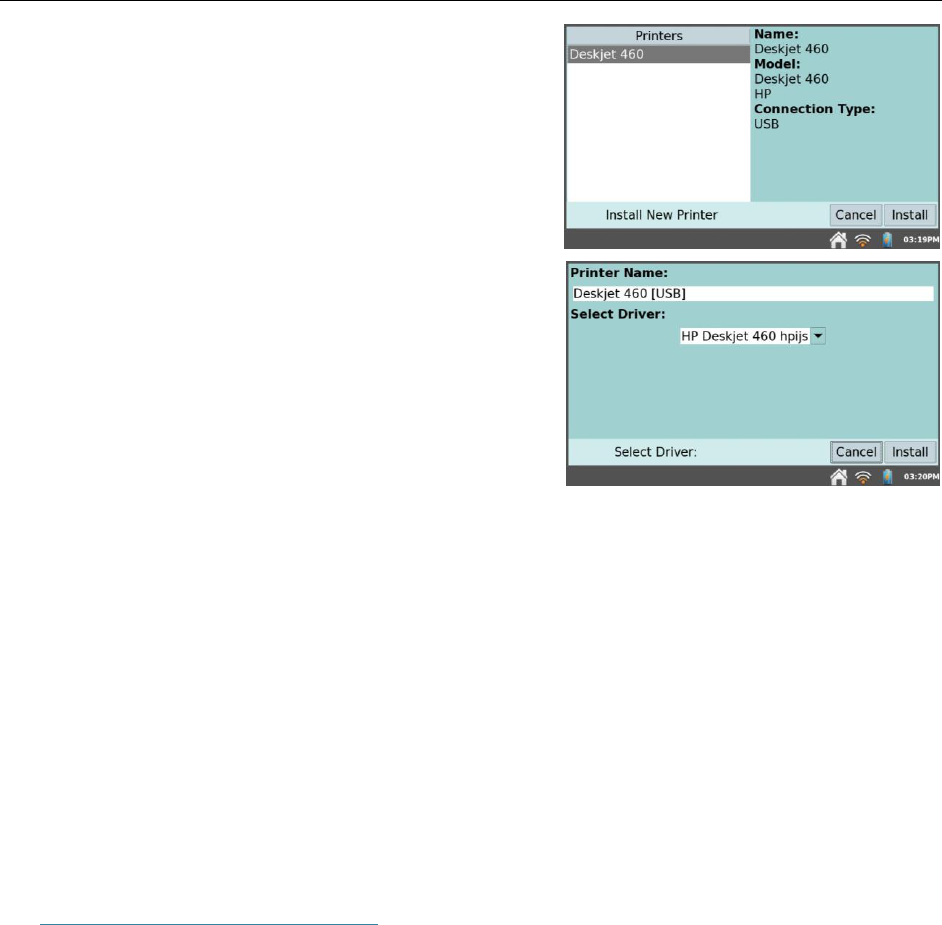
LabQuest App
27
3. Select the printer that appears in the list and tap
Install.
4. Tap Install again to complete the printer installation
process.
5. Close the Printer Configuration by tapping the X at the top right of the screen. This
procedure need only be performed the first time you connect a particular printer.
To print, choose Print from the File menu. Tap to choose the item that you want to print. The
Print Options screen appears and you may choose the printer and enter a Title and/or Footer for
your printout. Tap Print to send the item to the selected printer.
Even though your printer may initially appear in the Printer list, a driver may not be found when
you tap the Install button. Not all printers are supported - see the compatible printer list above. If
a driver is found, printing may still error due to an incompatible printer - see the incompatible list
at the end of the compatible list above. If you are sure that the printer is compatible and you are
still getting an error, it may be caused by one of the following conditions: out of paper, out of
ink/toner, a door on the printer is ajar, a paper jam, or you may have selected the wrong printer
on the Print Options screen.
If you have access to a Wi-Fi enabled printer, you can print wirelessly. For detailed instructions,
see Wirelessly Printing from LabQuest.
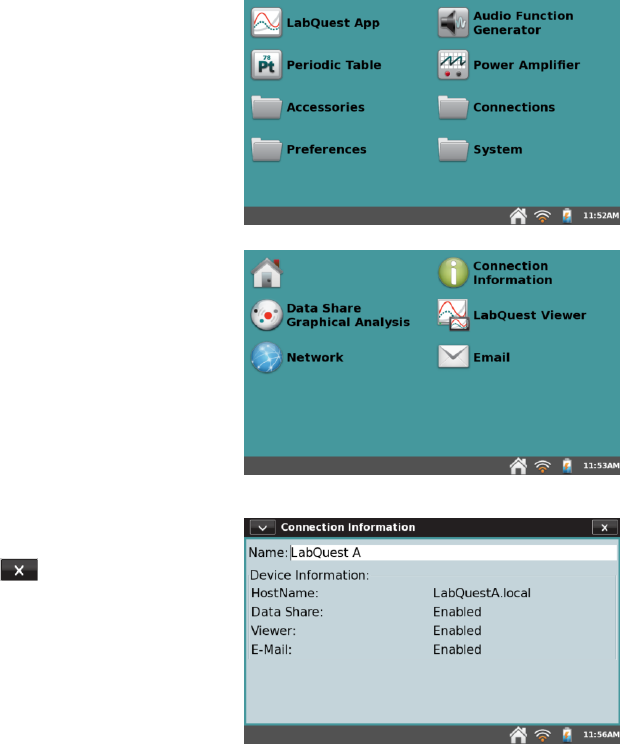
IV. USING LABQUEST 2 WITH A MOBILE DEVICE
LabQuest 2 includes Vernier Data Share, a feature that broadcasts sensor data to one or more
devices wirelessly from the LabQuest 2 interface. Using a compatible web browser, students can:
collaboratively collect experiment data
analyze an individual copy of the data on their device
examine their data and perform analyses such as statistics, linear fits, and quadratic fits
add a title and comment to their graph
use photo or screenshot features on their device to capture an image of the graph for their
lab report
Data Share is used with our Connected Science System, a networked collection of technology
that supports hands-on, collaborative learning with individualized accountability.
To use LabQuest 2 with a mobile device, follow these instructions.
Set up data sharing on LabQuest
1. From the Home screen, tap Connections.
2. From the Connections screen, tap Connection
Information.
3. From the Connection Information dialog box, tap
the Name field to enter a name for the LabQuest
(e.g., LabQuest A). Then tap to close this
window.
Note the HostName that is displayed. The
HostName will be a combination of the name
(without spaces) followed by .local (e.g.,
LabQuestA.local).
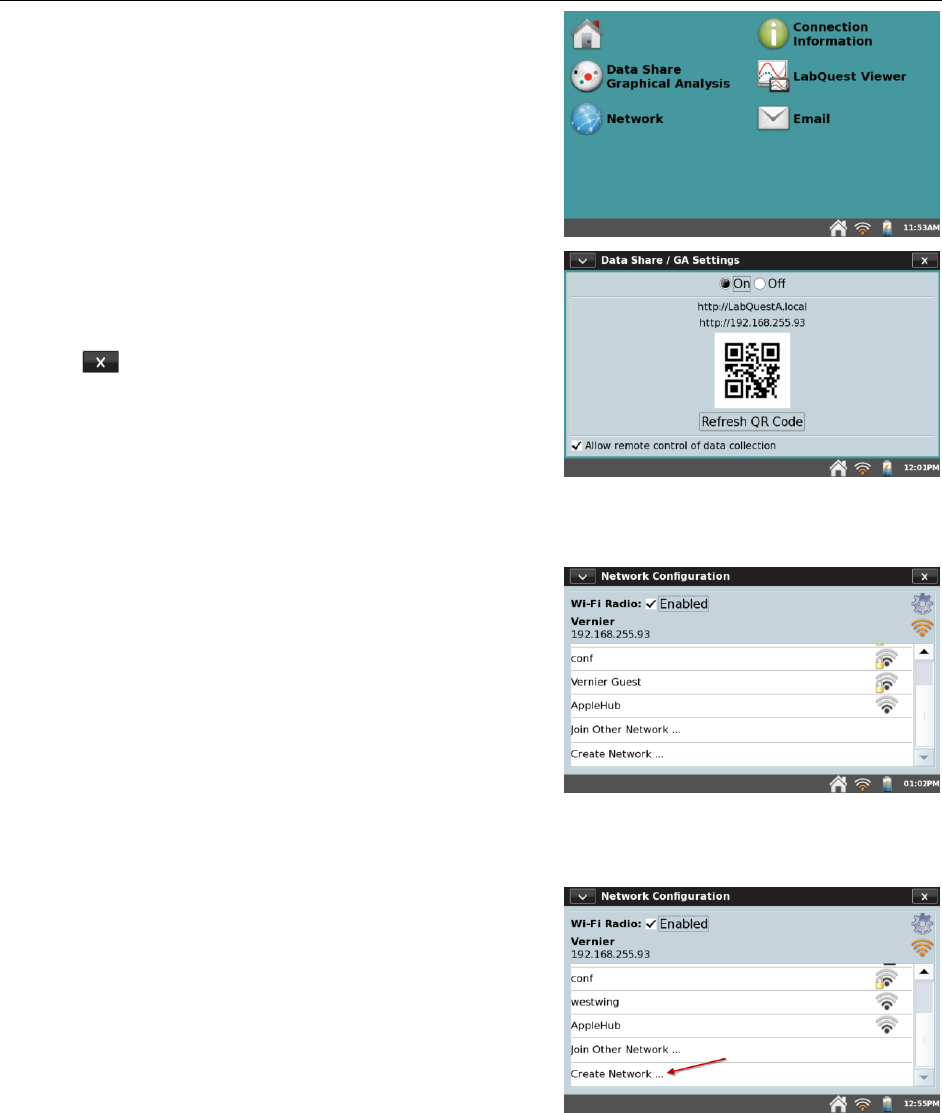
Using LabQuest 2 with a Mobile Device
29
4. From the Home menu, tap Connections, then tap
Data Share/Graphical Analysis.
5. From the Data Share/Graphical Analysis dialog,
turn on data sharing by tapping On. Optionally, you
can also choose to allow remote control of data
collection on the LabQuest from the mobile device.
Tap to close this window.
Connect LabQuest to a Network
6. Tap Connections on the Home screen, then tap
Network.
7. Tap to enable the Wi-Fi radio.
A Network Configuration dialog box is displayed
listing any networks that LabQuest sees, as well as
an option to Create Network.
Existing network
If you have an existing network to which you would like to connect, locate the network
within the list and tap to select.
Create a new LabQuest Network (Ad-Hoc Network)
If you do not have access to an existing Wi-Fi
network, or are not permitted to access your school's
network, you can quickly and easily set up a
network with LabQuest 2.
Note: This will allow your students to connect to
this network with their mobile devices. This network
will not support access to the internet. The email
function of LabQuest will not work with a LabQuest
ad-hoc network.
From the Network Configuration box, tap Create Network.
Tap the Network Name field and assign a name to this new network (e.g., Ms. Johnsons
classroom).
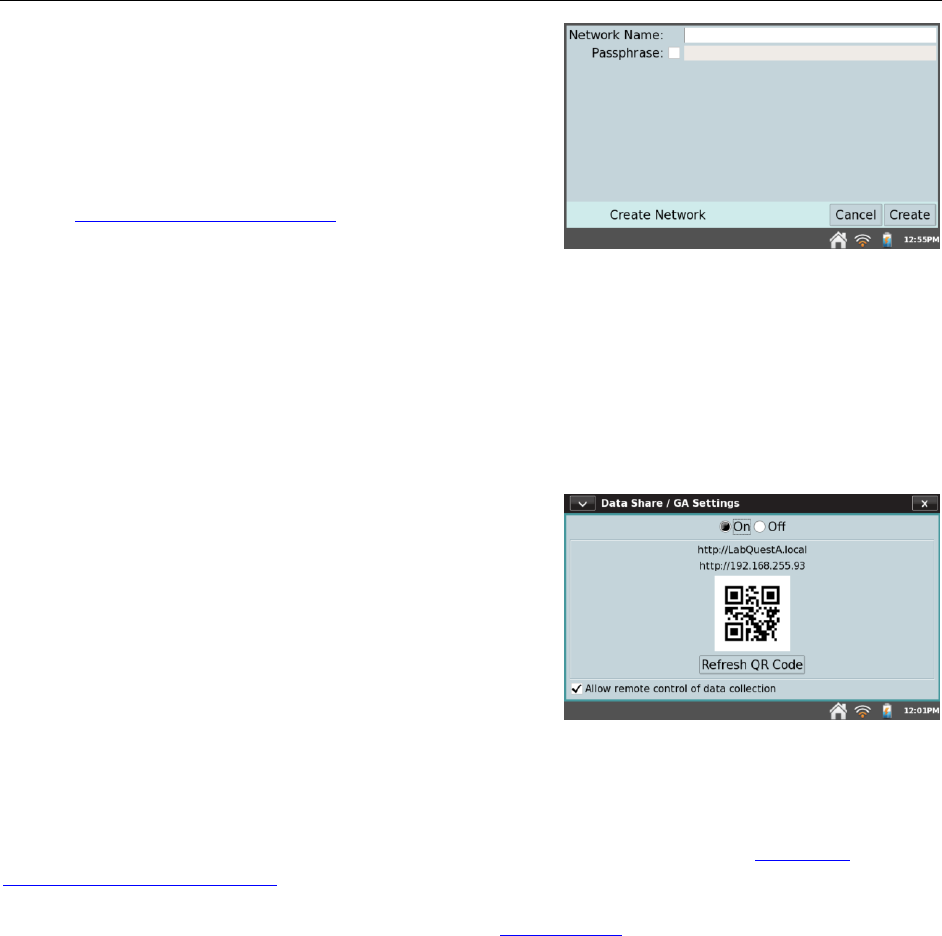
Using LabQuest 2 with a Mobile Device
30
Optional: Protect your network by assigning a
password to your network that you will provide
only to your students. To do this, select the
Passphrase check box and assign a password to
your new network (e.g., science). The
Passphrase must meet certain criteria. See our
web site for additional information:
www.vernier.com/til/2699/
Tap Create.
Note: Some Android implementations seem to have trouble viewing and connecting to ad-hoc
networks. These devices require the use of an existing (infrastructure) network.
Access LabQuest from your Mobile Device
8. On your mobile device, connect to the same network to which LabQuest is connected
(step 7).
9. On your mobile device, open the browser and type
in the HostName for your device (e.g.,
LabQuestA.local).
Optional: If your mobile device has a QR-code
reader, tap Connections from the Home screen on
LabQuest and then tap Data Share/Graphical
Analysis. A QR-code associated with the HostName
is displayed. Use a QR-scanning application on
your mobile device to connect to your LabQuest.
Access LabQuest from your iPad®
If your classroom has iPad devices, you might be interested in purchasing our Graphical
Analysis™ for iPad App. This app is used with our Connected Science System, a networked
collection of technology that supports hands-on, collaborative learning with individualized
accountability. This app can be purchased from the App Store. Educational discount pricing is
available.
Graphical Analysis for iPad supports advanced networking and exporting capabilities, providing
additional features such as:
automatic discovery of LabQuest 2
advanced curve fits
manual data entry
prediction tool
auto-saving of projects
exporting of graphs and/or data
printing

V. USING LABQUEST WITH A COMPUTER
LabQuest comes with Logger Lite computer software. Use either Logger Lite 1.6 (or newer) or
Logger Pro 3.8.5 (or newer) with LabQuest 2. If you already own Logger Pro 3, updates to
Logger Pro are available for free download at www.vernier.com/updates/logger-pro/
LabQuest can be used with a computer in one of two ways: (1) data can be collected directly to
Logger Pro or Logger Lite, or (2) you can transfer previously collected data from the LabQuest
to either program. Each of these is described in more detail as follows.
Collecting Data with Logger Lite or Logger Pro
1. Connect a sensor to LabQuest.
2. Connect LabQuest to your computer using the included USB cable. The mini end of the
cable connects to LabQuest, and the full-size end connects to an available USB port on
your computer.
3. Open Logger Pro or Logger Lite on your computer. The computer will detect the
LabQuest and the attached sensor, and display a graph ready for data collection.
LabQuest will display a screen with two arrows indicating it is connected to the
computer.
4. Click the Collect button in Logger Pro or Logger Lite to collect data.
Transferring Data from LabQuest to a Computer
Automatically Transferring Data
If you collect data in LabQuest App, and you then connect the LabQuest to a computer,
Logger Lite or Logger Pro will automatically detect the presence of the remote data and offer to
retrieve it.
To try this, collect data on LabQuest and then connect the LabQuest to your computer and
launch Logger Lite or Logger Pro. The computer application will detect the LabQuest and its
data, and display a dialog indicating that remote data are available. Follow instructions in that
and subsequent dialogs to download data to the computer.
Note: If you want to automatically transfer data from a LabQuest to a computer from a file that
has been stored on your LabQuest, you must first open the file on the LabQuest.
Manually Transferring Data
In addition to the automatic detection of recent data in LabQuest by Logger Pro or Logger Lite
(described in the preceding sections) you can also download any saved data from LabQuest to
the computer. After an experiment is complete on LabQuest, choose Save from the LabQuest
File menu. Give the experiment an identifying name. You may save multiple LabQuest files on
LabQuest this way.
Tip: When taking data in the field, store experiments as files on the LabQuest. To do this, choose
Save from the File menu, and give the experiment a descriptive name. Choose either the

Using LabQuest with a Computer
32
LabQuest, or optionally a USB drive or SD card, as the location. This way you can save as many
experiments as you like. Later, you can either use LabQuest Browser in Logger Pro or
Logger Lite to open the files, or connect the USB drive or SD card to your computer and open
the files directly in Logger Pro or Logger Lite.
On the computer, choose Open from the LabQuest Browser, which is found in the File menu.
Select the desired file from the LabQuest, and open it. Your LabQuest file will be opened on the
computer, including any data, notes, and data collection configuration. Only one file can be
opened at a time. You may choose to subsequently save the data as a Logger Pro or Logger Lite
file.
Tip: If sensors are still connected when a LabQuest file is opened in Logger Pro or Logger Lite,
the sensors will be ignored. To enable the sensors, choose New from the File menu in the
computer application.
Another option is to Import data from the LabQuest. Import differs from Open in that only the
data in the LabQuest file are added to the current computer session. This allows you to compile
data from multiple LabQuest sessions into a single computer session for graphing and
comparison.
Tip: Compile class results from multiple LabQuest files (or multiple LabQuests) by repeatedly
importing data into a single Logger Pro or Logger Lite file.
Manually Moving Data from Computer to LabQuest
Data and/or sensor configurations can be saved to the LabQuest from your computer. Open a
computer file, or set up the computer for the data collection details you desire. Choose Save As
from the LabQuest Browser (found in the File menu), and enter a descriptive file name. Any
data, and the sensor configuration, will be stored on the LabQuest as a LabQuest file. Any
features in the computer file not existing on LabQuest (such as embedded images, video analysis,
graph annotations, or most calculated columns) will be ignored on LabQuest.
Deleting Data on LabQuest
The LabQuest Browser includes a Delete function. Choose Delete from the LabQuest Browser,
and select the file you want to remove from LabQuest.
Tip: Use the LabQuest Browser to mass delete files from LabQuest. Click to select multiple files,
and click Delete. This is the only way to delete more than one file at a time.
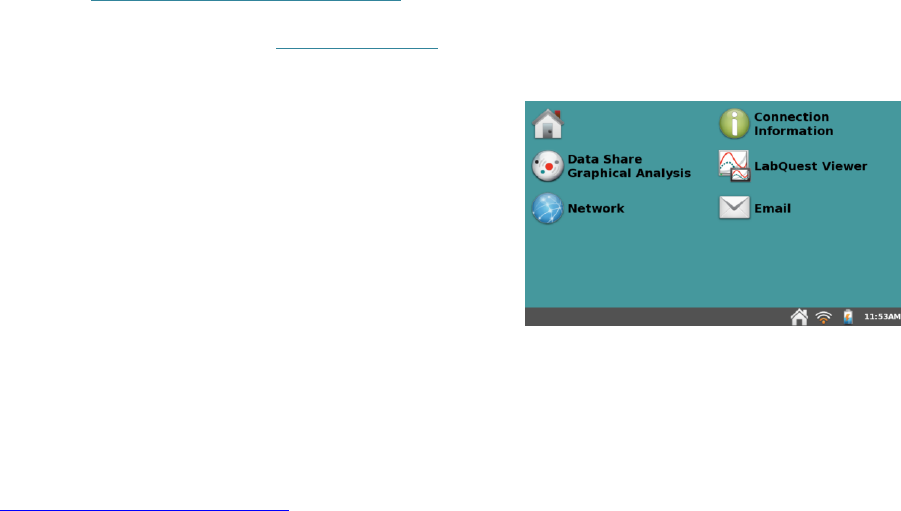
VI. EMAILING FROM LABQUEST
If LabQuest is connected to a network with Internet access, you can email your data file, graph,
text file, or screen shot.
To set this up, follow these instructions:
1. First, you will need to connect LabQuest to a network with Internet. To do this, follow steps
6-8 from Connect LabQuest to a Network.
Note: A LabQuest Network (Ad-Hoc Network) does not have Internet access. You will need
to join an existing network with Internet.
2. From the Home screen, tap Connections, then tap
Email.
3. The Email Configuration dialog box is displayed. Enable email by selecting On.
4. Enter your outgoing email server information and tap Save. For additional information, see
www.vernier.com/networking
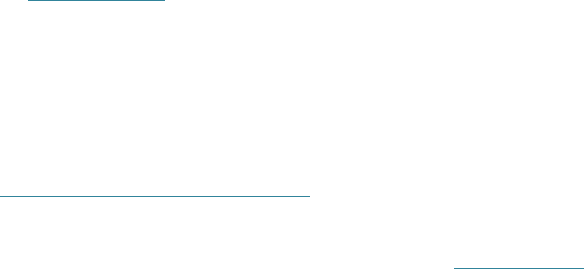
VII. WIRELESSLY PRINTING FROM LABQUEST
As described in USB Printing you may print wirelessly by connecting directly to a compatible
Wi-Fi enabled printer or by connecting to a Wi-Fi access point that is wired to a network which
includes a compatible printer.
You can set this up as follows:
1. First, you will need to connect LabQuest to a network with Internet. To do this, follow steps
6-8 from Connect LabQuest to a Network.
2. Once you have connected, either to the Wi-Fi printer itself, or to a Wi-Fi access point, you
are ready to follow the same instructions as described in USB Printing.

VIII. PROJECTING AND MONITORING STUDENTS’ LABQUEST DEVICES
Use our LabQuest Viewer software (order code, LQ-VIEW) to view and control the LabQuest
wirelessly from your Windows or Macintosh computer. When LabQuest 2 is connected to a
computer wirelessly or via USB, LabQuest Viewer can be used in conjunction with a projector to
share the LabQuest 2 screen with the entire class.
This allows an instructor to demonstrate LabQuest 2 for a class, and also allows students to share
or present their work to fellow classmates. LabQuest Viewer can also be used with an original
LabQuest connected wirelessly to a computer via a Wi-Fi adapter. LabQuest Viewer is part of
the Connected Science System.
With LabQuest Viewer, you can:
View and control one or more LabQuests from a computer
Connect to a computer and projector or interactive white board for class demos or sharing
Monitor student progress on any LabQuest connected to your network
Create screenshots of the LabQuest screen to copy and paste into lab instructions
Set customizable permissions that permit viewing without control, or password-protect a
connection
Install LabQuest Viewer on any computer in your school or college department with the
included site license
System Requirements
Windows – Windows XP (32 bit only), Vista (32 and 64 bit), and Windows 7 (32 and 64
bit)
Macintosh – Macintosh OS X 10.5 (Intel-based Macs only), 10.6, and 10.7
LabQuest Compatibility
LabQuest 2 (Wi-Fi or USB connection)
LabQuest with Wi-Fi USB Adapter (Wi-Fi only)
For additional information, see: www.vernier.com/lq-view
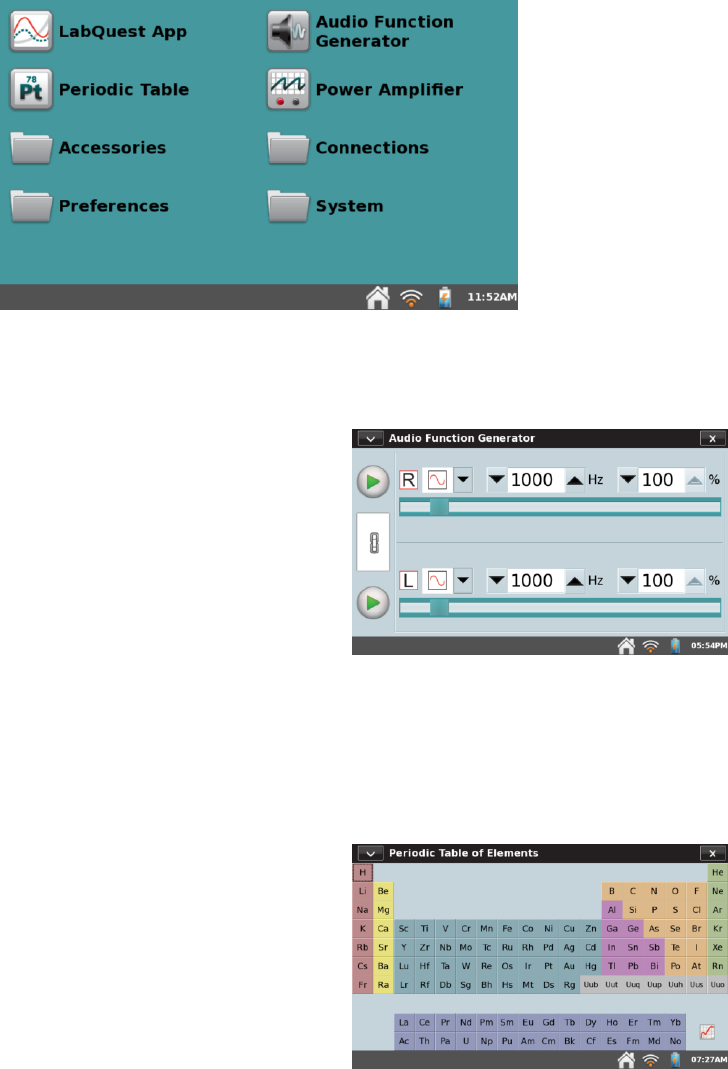
IX. ADDITIONAL APPS ON LABQUEST
Several accessory applications can be launched from the Home menu. It is not necessary to quit
the LabQuest App to use these accessories; to return to LabQuest App, either close the accessory
using the close button in the upper right corner of the screen, or switch to the LabQuest App by
tapping LabQuest App from the Home menu.
Access additional apps and accessories from the Home screen
Audio Function Generator
From the Home screen, tap Audio Function Generator
to launch this app. The function generator is used to
create waveforms in the audio frequency range. Select a
waveform, frequency, and volume for each channel.
Start and stop using the buttons at left. The link between
left and right channels is on by default, so that both start
and stop together. Click the link icon to control the
channels independently.
The sliders can also be used to control frequency. Tapping left or right of the slider will halve or
double the frequency.
A common use of the Audio Function Generator is to create tones and beats for waveform study
using a microphone. For the best waveform quality, connect a powered computer speaker to the
audio output jack of LabQuest.
Periodic Table
From the Home screen, tap Periodic Table to launch
this app. The Periodic Table contains standard reference
information on the elements. Tap an element to see
details; close the detail window using the upper right
close button.
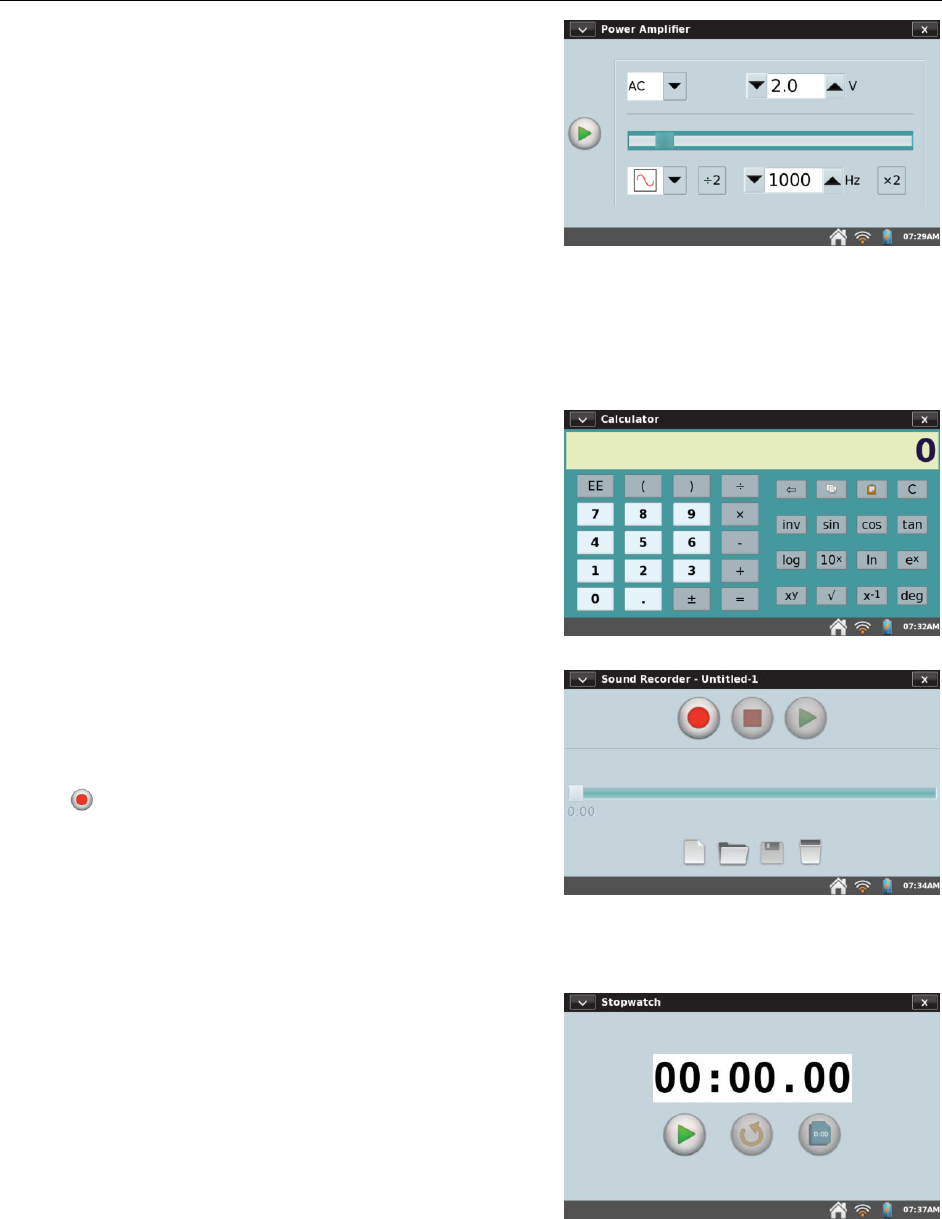
Additional Apps on LabQuest
37
Power Amplifier
From the Home screen, tap Power Amplifier to launch
this app. The Power Amplifier App is used to control
the Vernier Power Amplifier (order code PAMP) used
to create waveforms with up to 10 V amplitude and
currents of 1 A. Connect the Power Amplifier to the
LabQuest audio output.
Select the desired output (AC or DC). DC output levels are limited to 0.2 V steps. AC
waveforms include sine, square, sawtooth, and ramps. Select an amplitude and frequency using
the controls. The frequency can be changed by factors of two using either the buttons, or in small
steps using the slider. Start and stop the output using the control at left.
Calculator
From the Home screen, tap Accessories, then tap
Calculator.
This app is a standard scientific calculator which uses
algebraic notation. You can use this calculator at any
time; to dismiss it, tap Home. You can copy a calculator
result and paste it into the Notes tab.
Sound Recorder
From the Home screen, tap Accessories, then tap Sound
Recorder.
The sound recorder is used to capture short audio clips,
typically for voice notes. To record a clip, tap the record
button . To stop, tap the square red stop button. Play
the clip back using the green play button. The disk
button allows you to save the clip, which can later be
opened using the open file folder icon. The blank page
icon clears out any current audio clip.
Tip: Use Sound Recorder to quickly make audio notes on experiments.
Stopwatch
From the Home screen, tap Accessories, then tap
Stopwatch.
The Stopwatch Application is a simple timer. Tap the
start button to begin timing; tap it again to stop.
Subsequent taps will continue to start and stop the
timer. Tap the middle reset button to return the timer to
zero. The copy button will place the current time on the
clipboard for pasting into the Notes screen of
LabQuest App, or into the calculator.

Appendix A – 1
APPENDIX A. LABQUEST 2 TECHNICAL SPECIFICATIONS
Display
11.2 cm x 6.7 cm (13.1 cm diagonal)
screen
800 x 480 pixel color display at 188 dpi
LED backlight
Portrait or landscape screen orientation
High-contrast mode for outdoor visibility
Processor
800 MHz Application Processor
Connectivity
Wi-Fi 802.11 b/g/n
Bluetooth for WDSS
User Interface
Resistive touch screen
Touch and stylus navigation for efficiency
and precision
Data Acquisition
100,000 samples per second
12-bit resolution
Built-in GPS, 3-axis accelerometer ( 2 g),
ambient temperature sensor, light sensor
(uncalibrated intensity), and microphone
Environmental Durability
Operating Temperature: 0 – 45°C
Storage Temperature: -30 – 60°C
Splash resistant
Rugged enclosure designed to withstand a
fall from lab bench
Size and Weight
Size: 8.8 cm x 15.4 cm x 2.5 cm
Weight: 350 g
Ports
5 sensor channels
USB port for sensors, flash drives, and
peripherals
USB mini port
DC power jack
MicroSD/MMC slot
Audio in and out
Storage
200 MB
Expandable with MicroSD and USB flash
drive
Power
Rechargeable, high-capacity battery
DC charging/powering through external
adapter (included)
Non-compatible Sensors
LabQuest 2 does not support the following
sensors at this time:
Digital Control Unit* (DCU)
Heat Pulser
Ohaus balance
* Not supported with LabQuest as a standalone
device. The DCU can be used with Logger Pro
software and LabQuest 2.

Appendix B – 1
APPENDIX B. LABQUEST MAINTENANCE
LabQuest Battery
LabQuest uses a high-quality lithium-ion battery. This is the same chemistry used in premium
laptop and cell phone batteries, and you can expect similar performance. There is never a need to
condition the battery by regular full discharge/charge cycles.
Use only the supplied AC adapter or optional LabQuest 2 Charging Station (order code
LQ2-CRG, sold separately) to charge the LabQuest battery. A replacement adapter can be
purchased from our web site (order code LQ-PS).
The battery takes about eight hours to completely charge. It is safe to leave the battery charging
indefinitely, and there is no need to fully discharge the battery before charging. Battery life will
depend on the sensors used, but in most cases you can obtain six or more hours of use before
recharging. We recommend charging LabQuest overnight to start the next day with a full charge.
For use with a computer, either the battery must be charged or the LabQuest must be connected
to AC power. The LabQuest cannot operate on USB power alone. When the LabQuest is running
and connected to the computer, the USB connection will, however, slowly charge the battery.
When using LabQuest as a standalone device, the screen will dim after a few minutes of no use,
even during data collection. However, LabQuest will not turn itself off until the battery is almost
discharged. No data will be lost, as LabQuest App will save a backup file before shutting down.
Battery life will depend on the sensors and features used. To optimize day-to-day battery life, set
the screen brightness to the minimum acceptable level, and turn off LabQuest when it is not in
use. Also disconnect any sensors you are not actively using. To access power-saving options, tap
Preferences on the Home Screen, then tap Light & Power.
The long-term life of the battery will vary, but you can expect about three hundred to four
hundred full charge/discharge cycles before the battery will need to be replaced. In this count, a
charge from half-way to a full charge would count as half of a charge cycle. In typical school
use, the battery can last three years or more. Exposure to temperatures over 35°C will
significantly reduce battery life.
As a battery reaches the end of its useful life, the run time will become shorter and shorter.
Eventually the run time will be too short for your application, and you will want to replace the
battery. Rechargeable batteries are considered a consumable, and as such are warranted for one
year. A replacement battery can be ordered from our web site (order code LQ2-BAT).
Recycling information is available at www.call2recycle.org.
LabQuest Case and Screen
The LabQuest is water and shock resistant. Do not submerge in liquids. Wipe clean with a damp
cloth only; do not use any solvents including ammonia or glass cleaners.
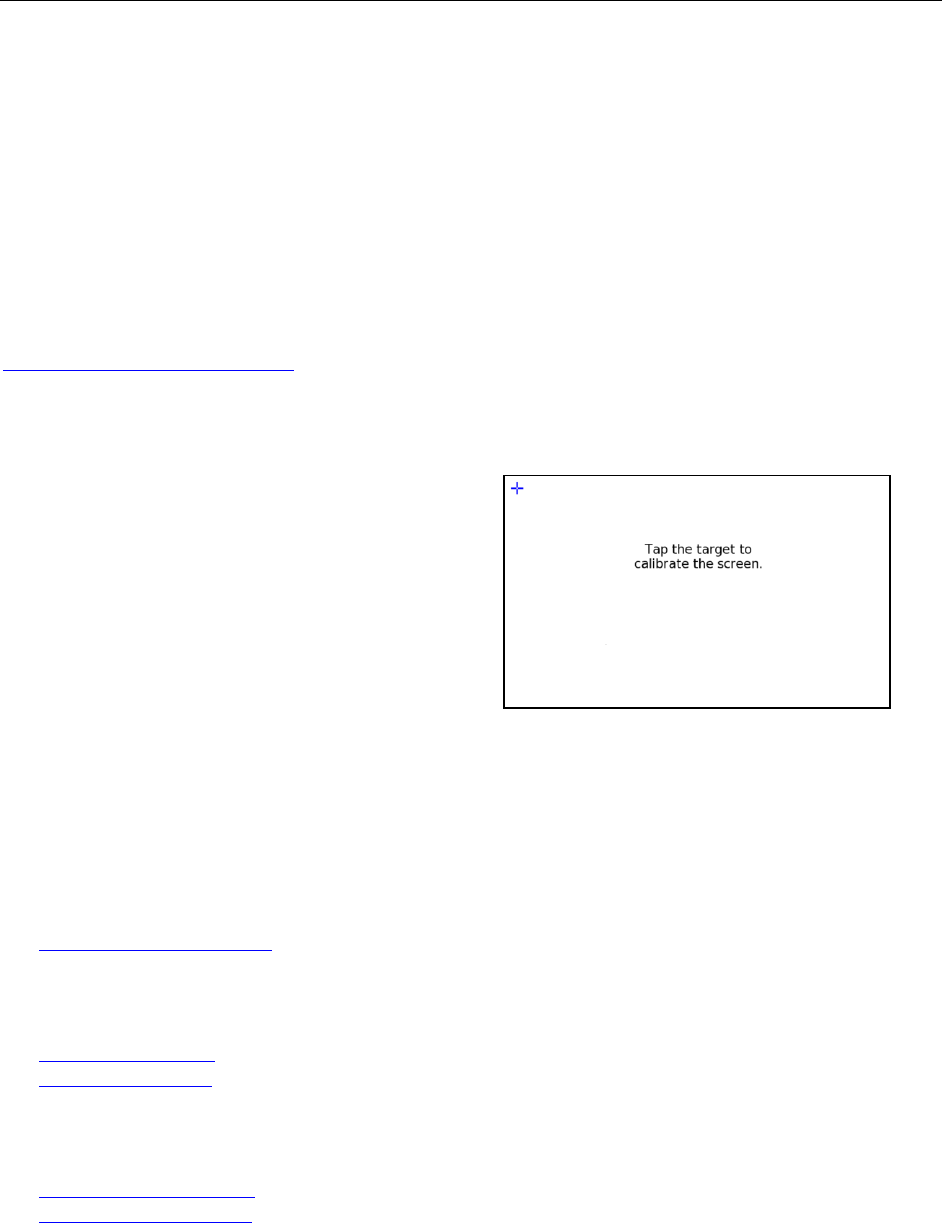
Appendix B – LabQuest Maintenance
Appendix B – 2
Stylus Tether
LabQuest includes a stylus and a tether. If desired, you can attach the tether to the stylus and the
LabQuest. Additional styluses are available from Vernier.
LabQuest Software
LabQuest arrives with its own software, LabQuest App, preloaded. The LabQuest App will be
updated from time to time to introduce new features and to improve performance. Most users
will want to run the latest version available.
Free updates with step-by-step instructions are available on our web site:
www.vernier.com/downloads/
Screen Calibration
To do this, tap System from the Home menu.
Then choose Calibrate Screen.
Follow the on-screen instructions for tapping the
plus sign with the stylus.
If you are unable to access the Calibration tool,
press and hold the Home key until the Calibration
tool is displayed.
Getting Additional Help
For access to user manuals, forums, and our technology information library, please visit our web
site at:
www.vernier.com/labq2
If you are located in the United States or Canada, you may also contact Vernier directly:
888.837.6437
info@vernier.com
www.vernier.com
Otherwise, please contact Vernier International:
941.349.1000
info@vernier-intl.com
www.vernier-intl.com
Appendix B – 1
APPENDIX C. LICENSE INFORMATION
This product contains certain open source software originated by third parties that is subject to
the GNU General Public License as published by the Free Software Foundation, GNU
Library/Lesser General Public License (LGPL) and different and/or additional copyright
licenses, disclaimers or notices. These licenses give you the right to redistribute and/or modify
the software.
The software is distributed in the hope that it will be useful, but WITHOUT ANY
WARRANTY; without even the implied warranty of MERCHANTABILITY or FITNESS FOR
A PARTICULAR PURPOSE. See the GNU General Public License for more details.
Complete source code for the open source software is available on request from Vernier
Software & Technology. Contact us at info@vernier.com, or by writing to
Source Code Request
Vernier Software & Technology
13979 SW Millikan Way
Beaverton OR 97005
USA
Source code will be made available for download, or you may request a CD-ROM of the code. A
shipping and handling fee will be charged for a CD-ROM.
The exact terms of GPL, LGPL and some other licenses are provided to you with the source code
distribution. You may also read the license at http://www.gnu.org/licenses/
Appendix D – 1
APPENDIX D. WARRANTY
Vernier warrants this product (with the exception of the battery) to be free from defects in
materials and workmanship for a period of five years from the date of shipment to the customer.
This warranty does not cover damage to the product caused by abuse or improper use.
The LabQuest 2 battery is a consumable, and as such, Vernier warrants this product to be free
from defects in materials and workmanship for a period of one year from the date of shipment to
the customer.
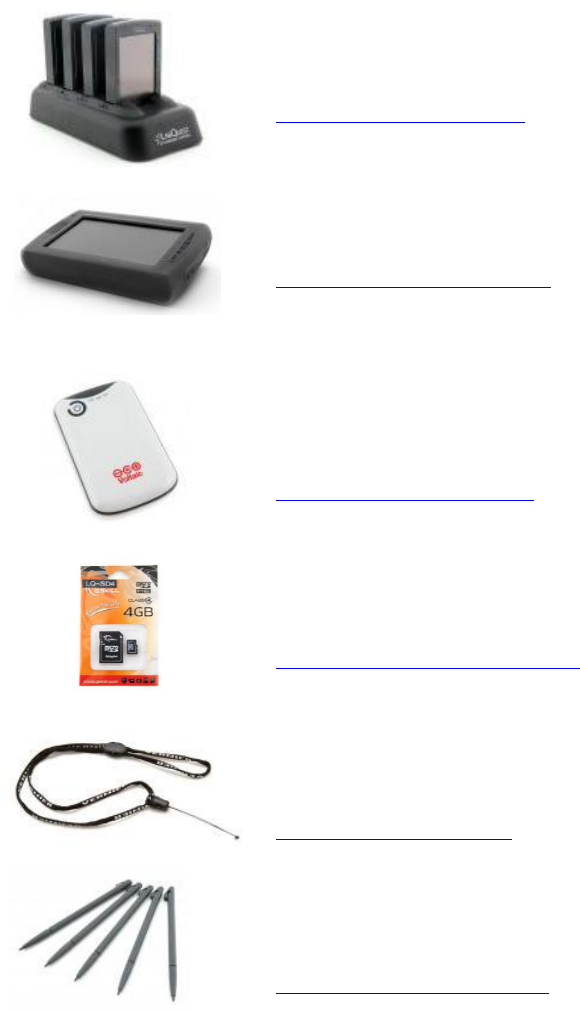
Appendix E – 1
APPENDIX E. ACCESSORIES, REPLACEMENT PARTS, AND
RELATED PRODUCTS
LabQuest 2 Charging Station
Charge and store up to four LabQuest 2 interfaces with this
compact and affordable station.
www.vernier.com/lq2-crg
LabQuest 2 Lab Armor
Add extra protection from spills and falls.
www.vernier.com/lq2-armor
LabQuest Battery Boost
With the added power of an external battery, data can be
collected for extended periods in the field where AC power
is not available.
www.vernier.com/lq-boost
LabQuest 4 GB SD Card
Easily add storage to your LabQuest or move files between
LabQuests or a computer.
http://www.vernier.com/lq-sd4/
Vernier Lanyard
A LabQuest neck strap to prevent accidental drops during
field studies.
www.vernier.com/lq-lan
LabQuest 2 Stylus (Set of 5)
Replacement LabQuest 2 styluses (5 pack). Two are included
with each LabQuest 2.
www.vernier.com/lq2-styl-5
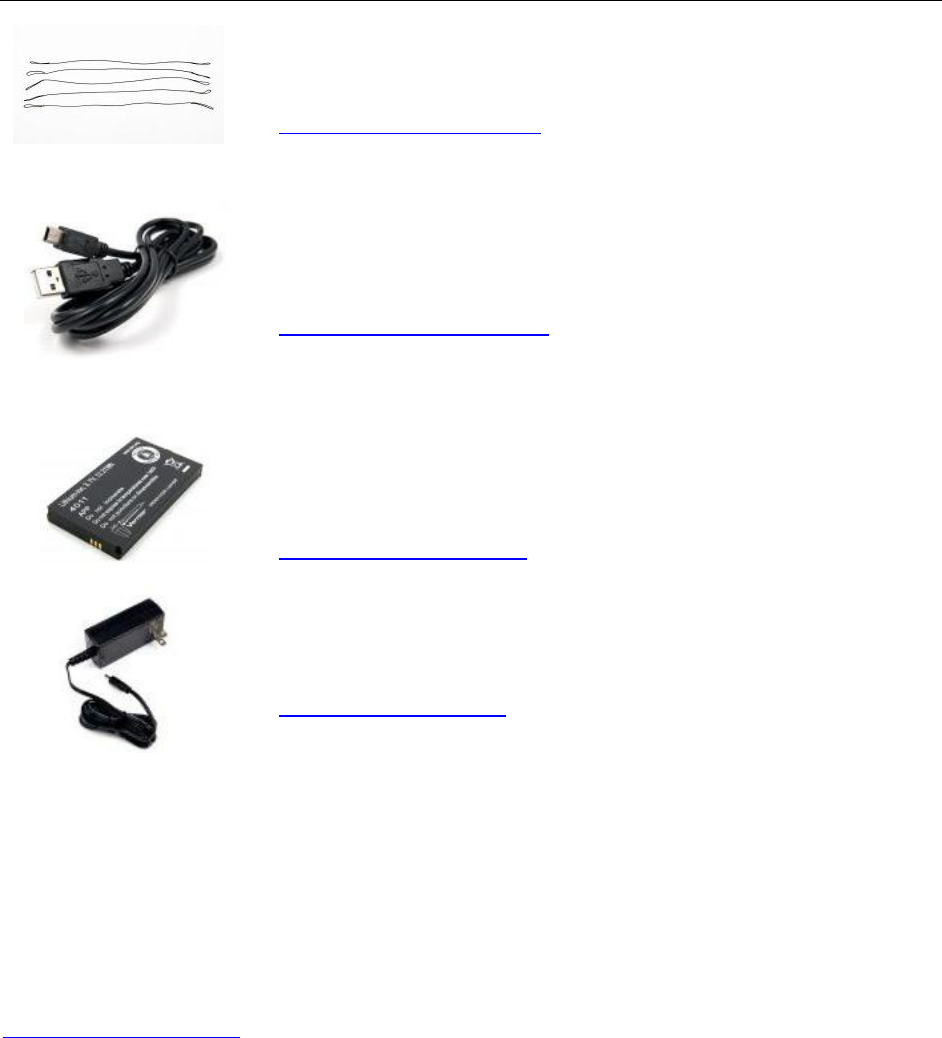
Appendix E – Accessories, Replacement Parts, and
Related Products
Appendix E – 2
LabQuest Stylus Tethers (Set of 5)
Replacement LabQuest tethers (5 pack). One is included
with each LabQuest 2.
www.vernier.com/lq-teth-5
LabQuest USB Computer Cable
Replacement LabQuest-to-computer USB cable. The cable
has a USB mini-B plug and USB standard-A plug. One cable
is included with each LabQuest 2.
www.vernier.com/lq-cb-usb
LabQuest 2 Battery
Replacement high-capacity, rechargeable, lithium-ion battery
for the Vernier LabQuest 2. One battery is included with
each LabQuest 2.
www.vernier.com/lq2-bat
LabQuest Power Supply
Replacement power supply for the LabQuest. One power
supply is included with each LabQuest 2.
www.vernier.com/lq-ps
Curriculum Resources from Vernier Software & Technology
Vernier lab books include a CD with word-processing files of the student instructions, essential
teacher information, suggested answers, sample data and graphs, and more. Download the
student instructions of our experiments to preview before purchasing. Either choose a lab book
or go to the experiments section to download previews. For more information, see
www.vernier.com/books
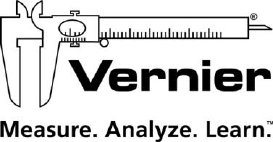
Vernier Software & Technology
13979 S.W. Millikan Way Beaverton, OR 97005-2886
Toll Free (888) 837-6437 (503) 277-2299 FAX (503) 277-2440
info@vernier.com www.vernier.com
Revised May 29, 2012
Logger Pro, Logger Lite, Vernier LabQuest, Vernier LabPro, Go! Link, Vernier EasyLink and other marks shown are our trademarks or
registered trademarks in the United States.
All other marks not owned by us that appear herein are the property of their respective owners, who may or may not be affiliated with, connected
to, or sponsored by us.